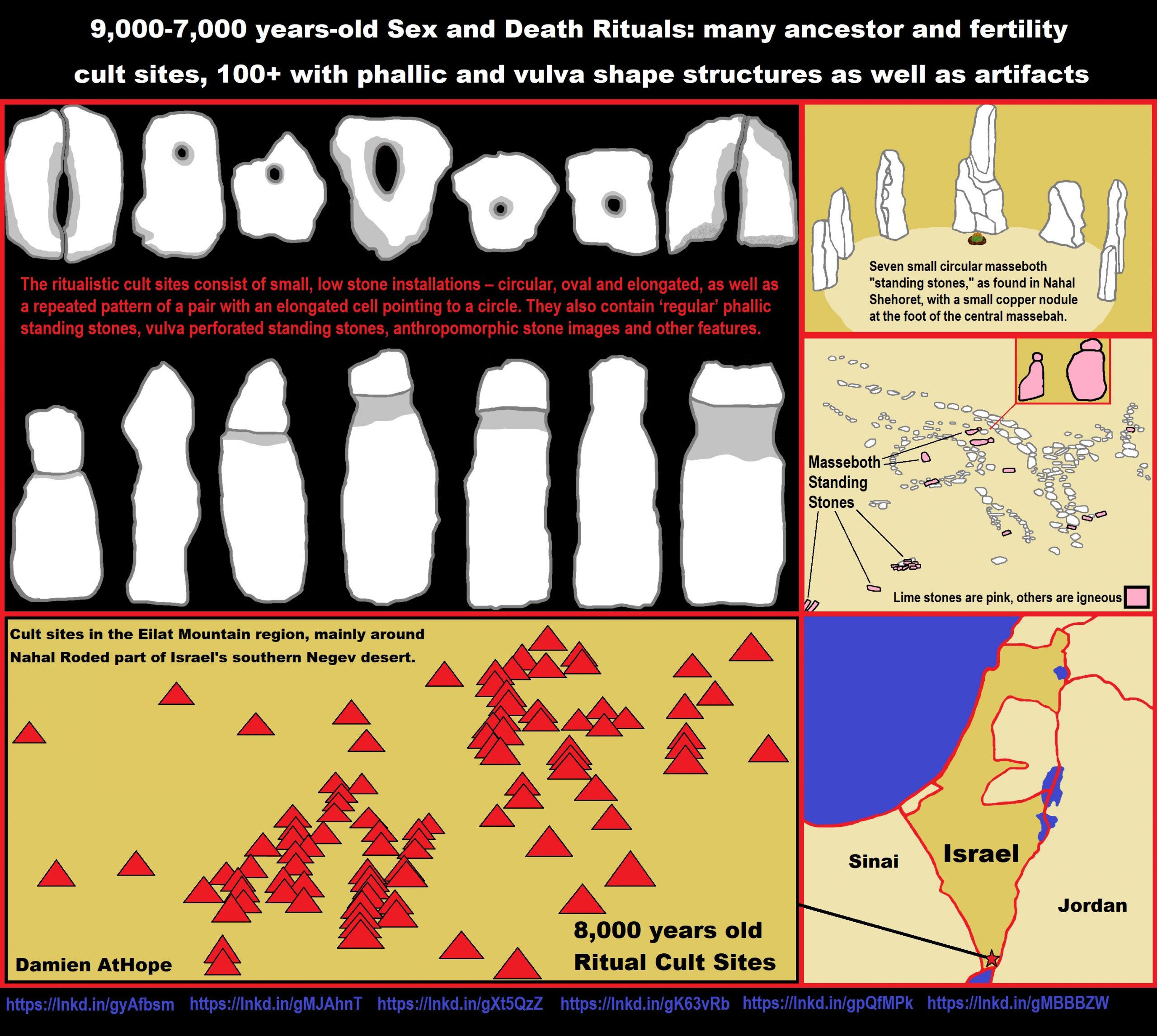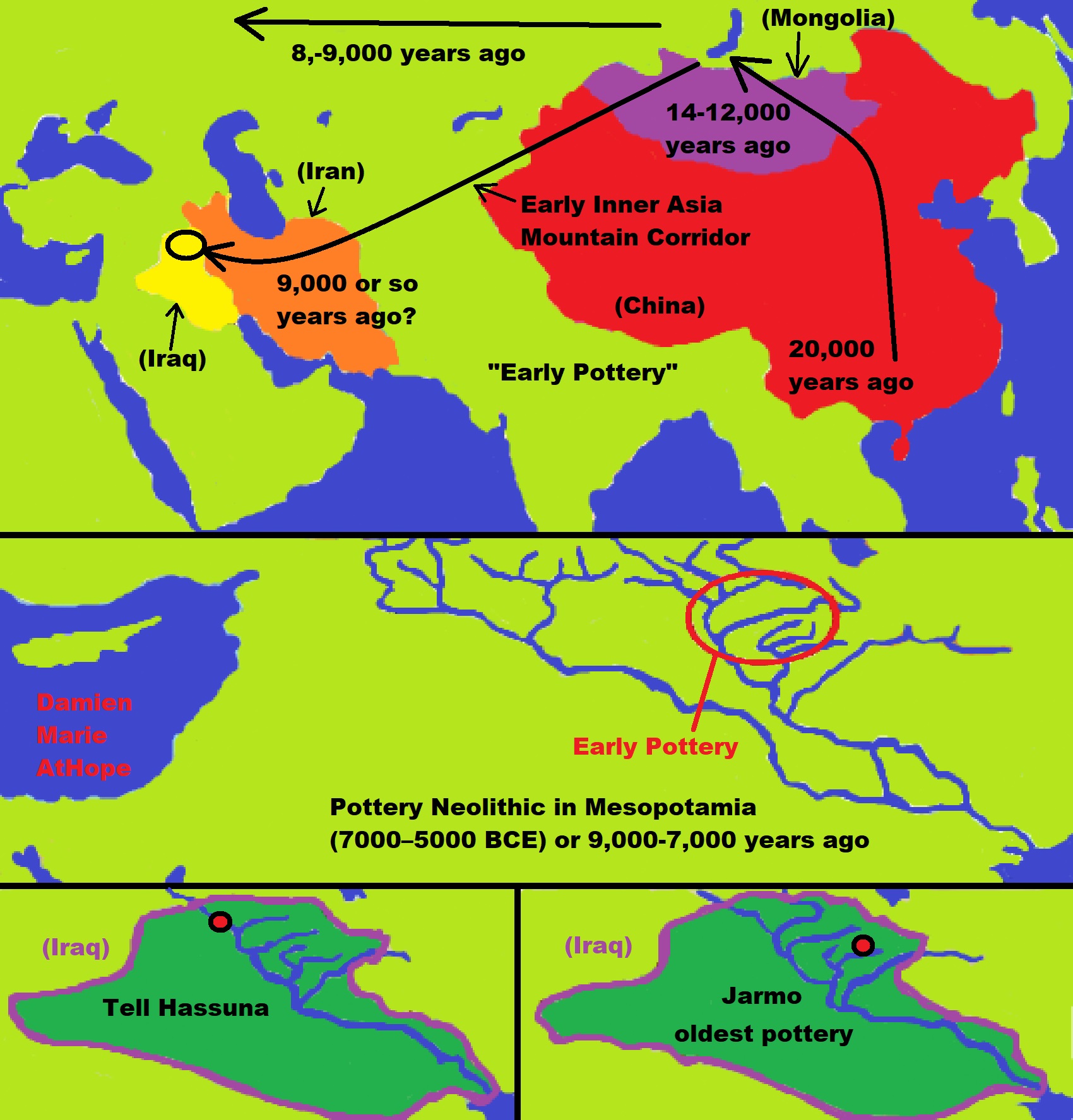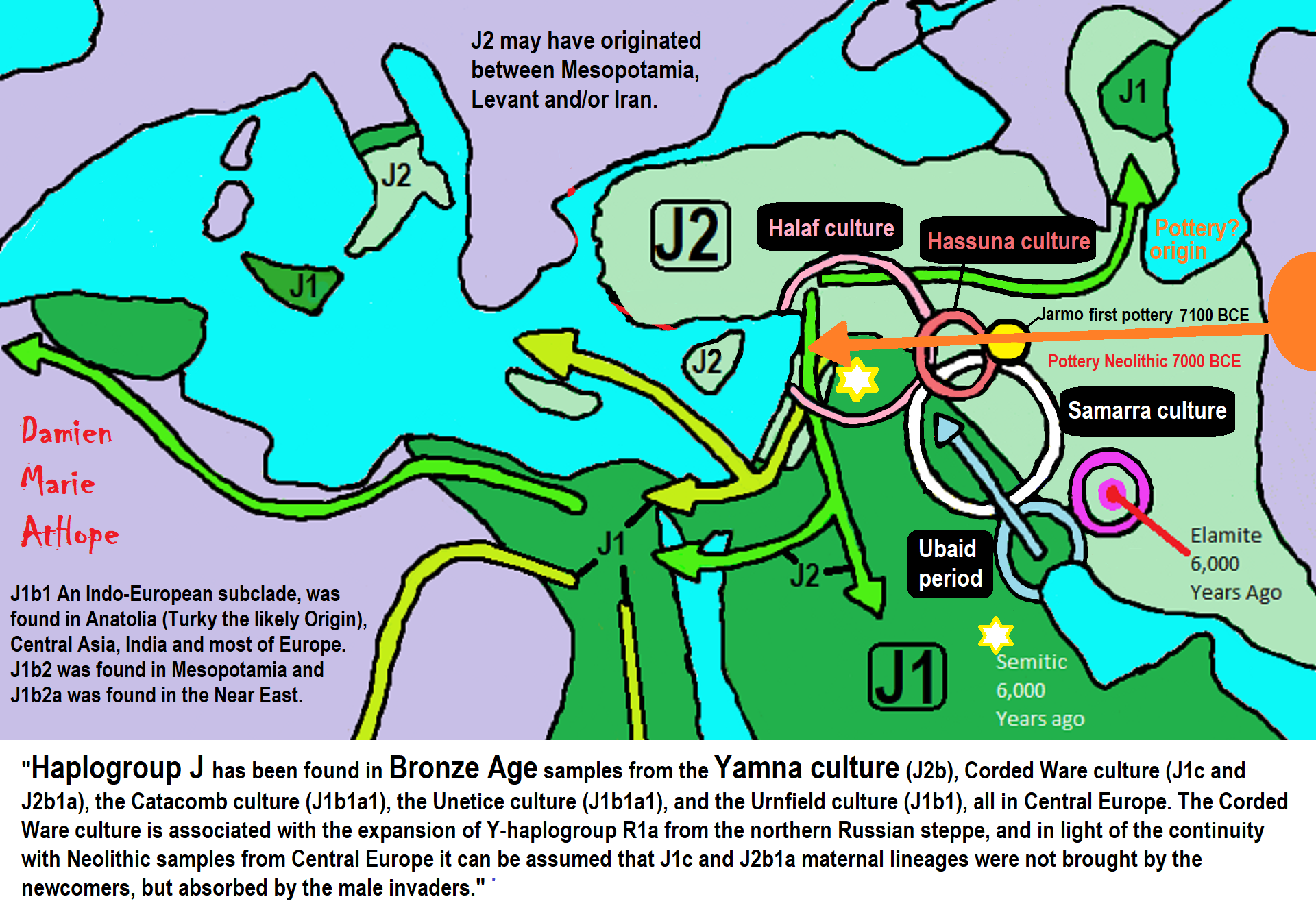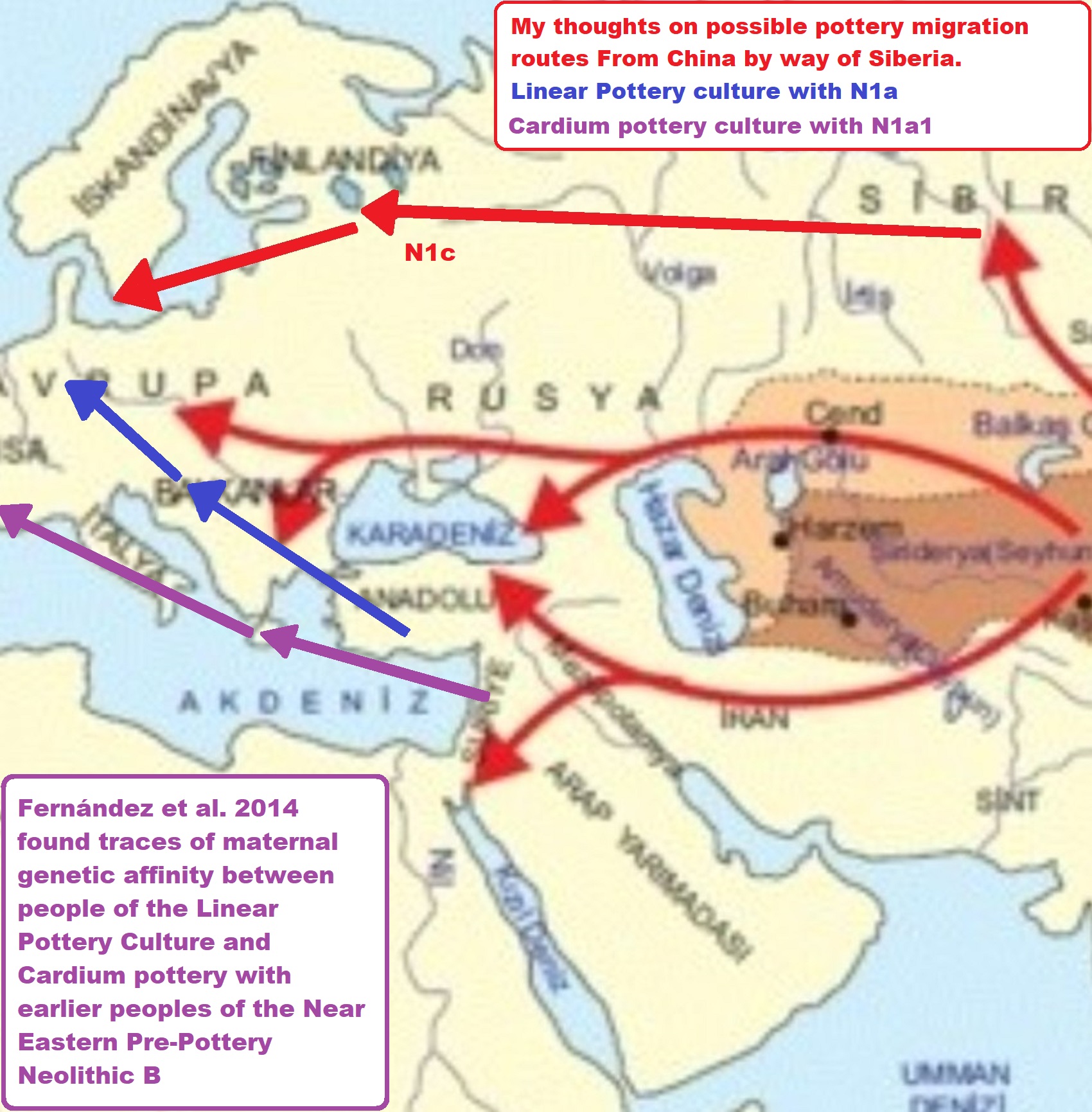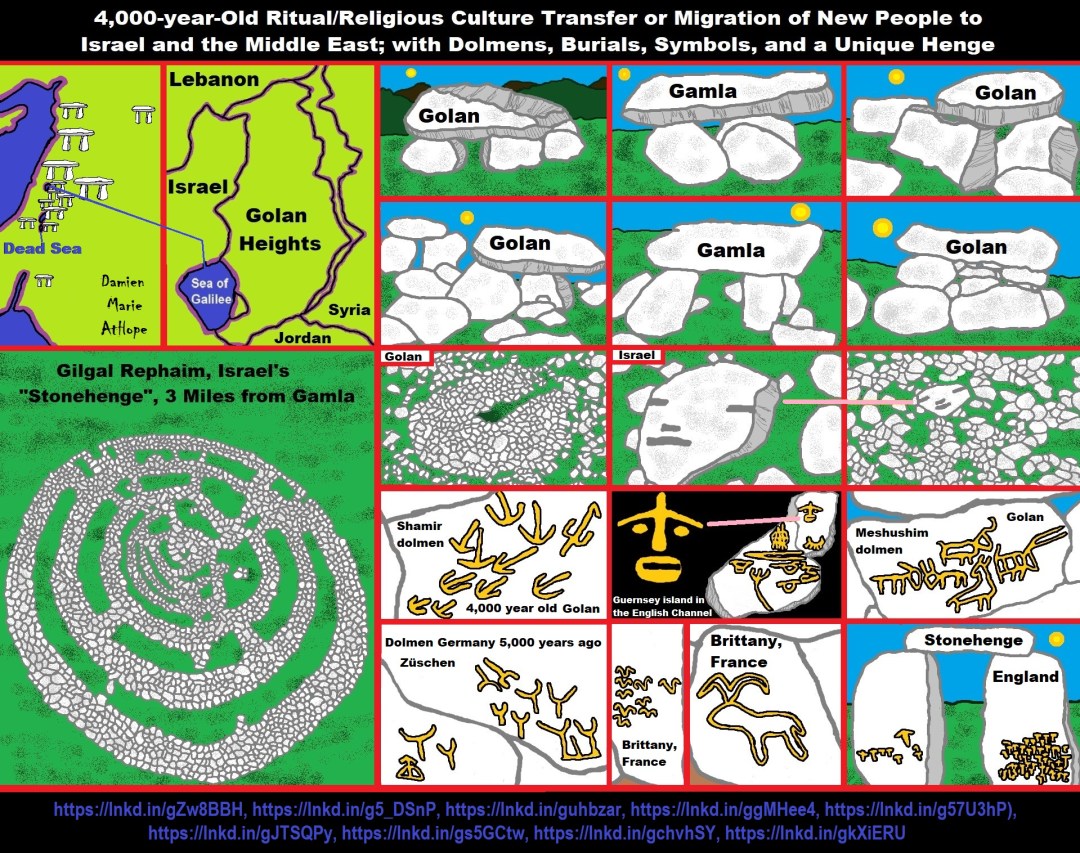
ref, ref, ref, ref, ref, ref, ref
Atlit-Yam (Pre-Pottery Neolithic C) is a 40,000-square-metre site/village, near Haifa, Israel, where its people lived in spacious stone houses, complete with paved floors, courtyards, fireplaces, storage facilities, and wells. As well as grain stores, graves, and a ritual stone circle. In the area are also twelve Pottery Neolithic sites. Most of the PN sites (Kfar-Samir; Hishuley Carmel; Kfar-Galim; Nahal Galim; Hahoterim; Tel-Hreiz; Megadim; Atlit north bay; Neve-Yam and Habonim) are attributed to the Wadi Rabah culture, considered as late Pottery Neolithic or early Chalcolithic, while the Neve-Yam North site belongs to the Lodian culture, which predates the Wadi Rabah culture. ref, ref, ref, ref, ref, ref, ref
Masseboth “Pillars” or “Standing Stones” and in the Singular, Massebah
“On the small ridges there are “Roded type” cult sites characterized by slabs of limestone which were brought from the seabed sediment range nearby.” ref
“Masseboth dot the landscape of the Bible’s desert lands. It’s the Hebrew Bible that calls them masseboth; singular, massebah), usually translated as “pillars” or “standing stones.” They are unmistakably purposeful arrangements of carefully selected crude stones set vertically into the ground, individually or in groups, and are abundant in the desert. The Bible makes it clear that these standing stones had a pervasive, if ambiguous, cultic significance in early Israelite religion. In these shrines masseboth stand alone or in groups—pairs and triads are the most common, but groups of five, seven and nine also occur. Some are only a few inches tall, while others are six feet or more. Most face east and many have at their base a carefully placed circular compartment or cell. Other features, such as offering benches, altars of different types and basins sometimes accompany masseboth. In addition to these independent sites, identical groupings of masseboth can be found at hundreds of tumuli (large stone heaps that mark a tomb) and in open-air sanctuaries.” ref
The Emergence of Masseboth and Their Bible Relations
“The earliest masseboth in the Near East are located in the Negev and the southern Jordan deserts and date to the 11th and 10th millennia B.C.E. (around 13,000-11,000 years ago) Masseboth became quite common from the sixth to the third millennia B.C.E. (around 8,000-4,000 years ago) and continued to be erected all through the Biblical period and later. In the fertile, non-desert areas of the Near East, however, they are much less common, especially at prehistoric sites; only in the second millennium B.C.E. (around 4,000-3,000 years ago) do their numbers significantly increase. The Bible and other ancient literature mention two types of masseboth: those representing gods and their abodes and those representing ancestral spirits.” ref
“Archaeology confirms the existence of both types; people in many traditional societies throughout the world still erect stones of the second type for their ancestors. In the ancient Near East the best-known reference to the ancestral massebah comes from The Tale of Aqhat, a narrative inscribed on 15th-century B.C.E. (3,500 years old) cuneiform tablets from Ugarit (on the Mediterranean coast of Syria). In the story, Dan-el, father of Aqhat, repeatedly complains to the gods that he “does not have a son to set up massebah in the temple in his name.” Although the translation of the last two words is controversial, the stone is clearly understood to contain and preserve the ancestral spirit.” ref
“One Biblical example is the story of Jacob at Beth-El. After he awakens from his dream of a ladder ascending to heaven, Jacob takes the stone that served as his pillow and sets it up, declaring, “This stone that I have set up as a pillar (massebah) shall be God’s house” (Genesis 28:22). He probably believed that the stone contained God’s power and spirit. Three inscribed basalt stelae or pillars were discovered near Sefire, Syria. These Sefire inscriptions, record an eighth-century B.C.E. (around 2,800 years ago) treaty between the vassal/king of Arpad and his overlord. The text, the longest intact inscription in Old Aramaic, contains over 100 legible lines. An introductory section invokes several well-known Syrian and Mesopotamian gods as witnesses to the treaty. It then identifies the stone pillars upon which the treaty is inscribed as the “house of god.” ref
“Later Arabian sources apply the same term, “house of god,” to standing stones. Similarly, a ninth-century B.C.E. (around 2,9,00 years old) Assyrian document describing King Tukulti Ninurta’s campaign to the Lebanon coast says that “he camped by the stones in which the great gods are dwelling.” Other masseboth offer variations on this theme. Some, by virtue of their divine authority, serve as witnesses to treaties and covenants; others oversee the fulfillment of vows and treaties, commemorate special events and bequeath divine protection upon territorial borders.” ref
Two Major Characteristics in Masseboth
*First, “in all groupings, the number of stones parallels the number of gods in various Near Eastern inscriptions, artistic representations and mythologies. Thus, a group of stones may represent a known group of gods.” ref
*Second, “a closer look reveals that most clusters of masseboth include stones of different shapes and proportions; moreover, the stones within a group are set in a symmetrical pattern or in some other order related to their shape.” ref
“For example, a group of seven stones at the top of Ma’aleh Jethro, east of the Uvda Valley, is set in a distinct pattern of alternating broad and narrow stones (see “Desert Masseboth: A Gallery of Types”). The stones were brought from some distance and obviously carefully selected, so we must assume some purpose or concept lay behind this arrangement. A similar relationship between broad and narrow stones or tall and short stones is found in other groups. Perhaps a narrow or tall stone represented a god, and a broad or shorter stone represented a goddess.” ref
Matzevah
“Matzevah or masseba (Hebrew: מַצֵּבָה maṣṣēḇā; “pillar”) is a term used in the Hebrew Bible for a sacred pillar, a type of standing stone. The term has been adopted by archaeologists for Israelite contexts, seldom for related cultures, such as the Canaanite and the Nabataean ones. As a second derived meaning, it is also used for a headstone or tombstone marking a Jewish grave. The Hebrew word matzevah is derived from a root meaning ‘to stand’, which led to the meaning of ‘pillar’. The singular form can be found spelled as masseba, maseba, matzevah, matzeva or mazzevah, and the plural form as massebot, masseboth, masebot, matzevot or matzevoth. When used in a Yiddish-influenced context, it can take the form matzeivah.” ref
“Use of the exclusive word can be found in Genesis 28:18, 28:22, 31:13, 31:45, 35:14, 35:20, Exodus 24:4, Deuteronomy 16:22, and Hosea 3:4. In Genesis 28:22, Jacob says “and this stone, which I have set up for a matzevah, shall be God’s house” and in Genesis 31:13 Yahweh says to Jacob “I am the God of Bethel [lit. “House of God”] where you anointed a matzevah and made a vow to me…”. The matzevah could also serve as a secular memorial: “Jacob set a pillar upon her grave: that is the pillar of Rachel‘s grave unto this day.” (Genesis 35:20) It could also stand as a symbolic witness: upon confronting Jacob in Gilead, Laban declared “This rock-pile is a witness, and this matzevah is a witness, that I will not pass this rock-pile, and you will not pass this rock-pile and this matzevah, for evil.” (Genesis 31:52).” ref
“Based on Genesis 35:20, observant Jews traditionally erect a monument at the grave of a deceased person. It can be placed either over the grave, as a footstone, or as a headstone. Three purposes can be distinguished. It may mark the gravesite for purity reasons, as priests (cohanim) are required to avoid defilement through contact with the dead, and a marker (any marker) helps them identify a grave. The name of the deceased written on a stone also allows friends and relatives to identify the grave. A respectable, but unostentatious monument appropriate to heirs’ fortune is also a symbolic way to honor the deceased.” ref
- Asherah pole, Canaanite object honoring Asherah, consort of Yahweh (BIBLE GOD)
- Baetylus, a type of sacred stone
- Bema and bamah (“High place”) elevated platform
- Ceremonial pole
- Lingam, abstract representation of the Hindu god Shiva
- Menhir, orthostat, or standing stone: upright stone, typically from the Bronze Age
- Stele, stone, or wooden slab erected as a monument
Menhir
“A menhir from Brittonic languages: maen or men, “stone” and hir or hîr, “long”), standing stone, orthostat, or lith is a large upright stone, emplaced in the ground by humans, typically dating from the European middle Bronze Age. They can be found individually as monoliths, or as part of a group of similar stones. Menhirs’ size can vary considerably, but they often taper toward the top. Menhirs are found across Europe, Africa, and Asia, with a concentration in Western Europe, notably in Ireland, Great Britain, and Brittany. Their purpose remains speculative, with theories ranging from druidic rituals to territorial markers or elements of an ideological system. Some menhirs feature engravings, including anthropomorphic figures and symbols, and are often associated with ancient religious ceremonies and burial chambers.” ref
“The word menhir was adopted from French by 19th-century archaeologists. The introduction of the word into general archaeological usage has been attributed to the 18th-century French military officer Théophile Corret de la Tour d’Auvergne. It is a combination of two words of the Breton language: maen and hir. In modern Welsh, they are described as maen hir, or “long stone”. In modern Breton, the word peulvan is used, with peul meaning “stake” or “post” and van which is a soft mutation of the word maen which means “stone”. In Germany and Scandinavia the word Bauta is used (e.g., de:Bautastein and no:bautastein) and this occasionally makes its way into English with the term “bauta stone.” ref
“Almost nothing is known of the social organization or religious beliefs of the people who erected the menhirs. Their language is also unknown. It is known, however, that they buried their dead and had the skills to grow crops, farm, and make pottery, stone tools, and jewelry. Identifying the purpose or use of menhirs remains speculative. Until recently, standing stones were associated with the Beaker people, who inhabited Europe during the European late Neolithic and early Bronze Age—later third millennium BC, c. 2800–1800 BCE. However, recent research into the age of megaliths in Brittany strongly suggests a far older origin, perhaps back to six to seven thousand years ago. During the European Middle Ages, standing stones were believed to have been built by the giants who lived before the biblical flood.” ref
“Many of the megaliths were destroyed or defaced by early Christians; it is estimated that some 50,000 megaliths once stood in Northern Europe, where almost 10,000 now remain. Menhirs have also been found in many other parts of the world. Many menhirs are engraved with megalithic art, some with anthropomorphic features. Other common carvings are identified as images of stone axes, ploughs, shepherds’ crooks, and yokes; and are named after these motifs. However, these identifications are not secure except for those of the stone axe images, and the names used to describe them are largely a matter of convenience. Some menhirs were broken up and incorporated into later passage graves, where they had new megalithic art carved with little regard for the previous pictures. It is not known if this re-use was deliberate or if the passage grave builders just saw menhirs as a convenient source of stone.” ref
“Where menhirs appear in groups, often in a circular, oval, henge, or horseshoe formation, they are sometimes called megalithic monuments. These are sites of ancient religious ceremonies, sometimes containing burial chambers. The exact function of menhirs has provoked more debate than practically any other issue in European prehistory. Over the centuries, they have variously been thought to have been used by druids for human sacrifice, used as territorial markers, or elements of a complex ideological system, used as mnemonic systems for oral cultures, or functioning as early calendars. Until the nineteenth century, antiquarians did not have substantial knowledge of prehistory, and their only reference points were provided by classical literature. The developments of radiocarbon dating and dendrochronology have significantly advanced scientific knowledge in this area.” ref
“Menhirs are widely distributed across Europe, Africa, and Asia, but are most numerous in Western Europe; particularly in Ireland, Great Britain, and Brittany, where there are about 50,000 examples, and northwestern France, where there are some 1,200 further examples. Standing stones are usually difficult to date. They were constructed during many different periods across prehistory as part of the larger megalithic cultures in Europe and near areas. Some menhirs stand next to buildings that have an early or current religious significance. One example is the South Zeal Menhir in Devon, which formed the basis for a 12th-century monastery built by lay monks. The monastery later became the Oxenham Arms hotel, at South Zeal, and the standing stone remains in place in the snug bar at the hotel. It is believed that practitioners of megalithic religions traveled via the sea, as the mass majority of menhirs are located on coasts, islands, and peninsulas.” ref
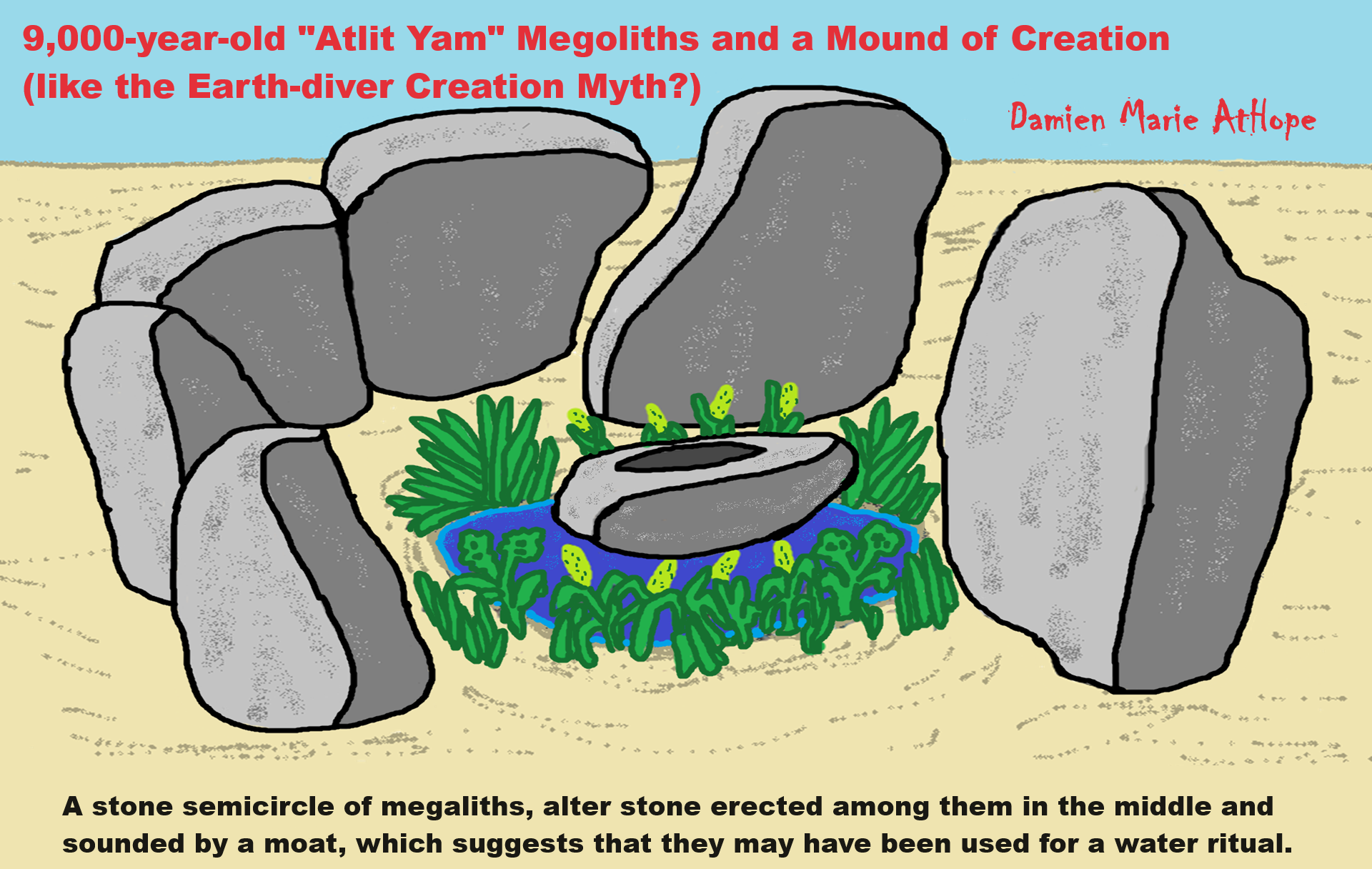
9,000-year-old “Atlit Yam” Megoliths and a Mound of Creation (like the Earth-diver Creation Myth?) A stone semicircle of megaliths, alter stone erected among them in the middle and sounded by a moat, which suggests that they may have been used for a water ritual.
Wadi Rabah culture
“The Wadi Rabah culture is a Pottery Neolithic archaeological culture of the Southern Levant, dating to the middle of the 5th millennium BCE. This period was first identified at the ancient site of Jericho (Tell es-Sultan) by British archaeologists John Garstang and Kathleen Kenyon in separate excavations. Kenyon has named this period in Jericho “Pottery Neolithic B”. The name “Wadi Rabah” was since used in archaeologic literature thanks to the works of Israeli archaeologist Jacob Kaplan at the site of Wadi Rabah. This culture is known from a small amount of sites, in some of which remains of small rectangular structures were discovered. Some larger structures were found in Munhata, Wadi Rabah and Ein el-Jarba, though Israeli archaeologist Yosef Garfinkel suggests that large courtyard structures were erected in that period, like the ones found at Sha’ar HaGolan of the preceding Yarmukian culture (c. 6400–6000 BCE) and Tel Tsaf of the following Early/Middle Chalcolithic period (c. 5300–4500 BCE).” ref
Lodian culture
“The Lodian culture or Jericho IX culture is a Pottery Neolithic archaeological culture of the Southern Levant dating from the first half of the 5th millennium BC, existing alongside the Yarmukian and Nizzanim cultures. The Lodian culture appears mainly in areas south of the territory of the Yarmukian culture, in the Shfela and the beginning of the Israeli coastal plain, the Judaean Mountains, and in the desert regions around the Dead Sea and south of it. The Lodian culture is defined by its distinctive pottery. It was first identified by John Garstang during his excavations of the eponymous Layer IX at Jericho. Thomas Levy later coined the term Lodian, shifting the type site to that of Lod, first excavated by Jacob Kaplan in the 1950s. The relationship between the Lodian culture and the two other Southern Levantine Pottery Neolithic cultures, the Yarmoukian and the Wadi Raba culture, has been debated for many years. Levy argued that it was a short-lived but distinct tradition that emerged after the Yarmoukian and before the Wadi Raba. Most known settlements associated with the Lodian culture were small and ephemeral. From the few sites remains of architecture have been found, it appears the inhabitants lived in circular, semi-subterranean rounded structures, 2-3 meters in diameter, made from mudbrick. Next to the structures were many pits dug by these inhabitants. They kept domestic animals, including sheep, goats, cattle, and pigs, and also fished and hunted wild gazelle. It is assumed that they also grew the typical Neolithic crops, e.g. cereals and legumes, but no archaeobotanical evidence has been recovered from Lodian sites to confirm this. Sites with Lodian material include Jericho, Lod, Tel Megiddo, Ghrubba, Teluliot Batashi, Tel Lachish, Tel Ali, Abu Zurayq, Wadi Shueib, Dhra′, Khirbet ed-Dharih, Nizzanim, and En Esur. Very few burials have been found at Lodian sites. The inhabitants may have disposed of their dead in other ways, or used dedicated cemeteries away from settlements, as the later Wadi Raba culture was known to do. Lodian pottery is identical in shape to the Yarmukian pottery but different in decoration. The typical Lodian pottery vessels are painted and burnished, with distinctive geometric motifs and vessel forms. Its lithic industry is dominated by flake tools, including several characteristic types of arrowheads (Haparsa, Nizzanim, and Herzlia points) and sickle blades. Bipolar cores, common in preceding cultures, disappeared during the Lodian. Figurines and other ritual objects are notably rare in Lodian assemblages, unlike the Yarmoukian. The flint tools area also similar to those of the Yarmukian. One distinctive type of flint tool that is unique to the Lodian culture is a rectangular sickle, shaped with pressure flaking.” ref
“Atlit Yam is an ancient submerged Neolithic village off the coast of Atlit, Israel. It has been carbon-dated as to be between 8,900 and 8,300 years old. Among the features of the 10-acre site is a stone circle. Atlit-Yam provides the earliest known evidence for an agro-pastoral-marine subsistence system on the Levantine coast. The site of Atlit Yam has been carbon-dated to be between 8,900 and 8,300 years old. In the 21st century, it lies between 8–12 m (25–40 ft) beneath sea level in the Mediterranean Sea, in the Bay of Atlit, at the mouth of the Oren river on the Carmel coast. It covers an area of ca. 40,000 square meters (10 acres). Underwater excavations have uncovered rectangular houses and a well. The site was covered by the eustatic rise of sea levels after the end of the Ice age. It is assumed that the contemporary coast-line was about 1 km (a half-mile) west of the present coast. Piles of fish ready for trade or storage have led scientists to conclude that the village was abandoned suddenly. An Italian study led by Maria Pareschi of the Italian National Institute of Geophysics and Volcanology in Pisa indicates that a volcanic collapse of the eastern flank of Mount Etna 8,500 years ago would likely have caused a 10-storey (40 m or 130 ft) tsunami to engulf some Mediterranean coastal cities within hours. Some scientists point to the apparent abandonment of Atlit Yam around the same time as further evidence that such a tsunami did indeed occur. A stone semicircle, containing seven 600 kg (1,300 lb) megaliths, has been found. The stones have cup marks carved into them and are arranged around a freshwater spring, which suggests that they may have been used for a water ritual. Ten flexed burials have been discovered, both inside the houses and in their vicinity. The skeletons of a woman and child, found in 2008, have revealed the earliest known cases of tuberculosis. Bone fish-hooks and piles of fish bones ready for trade or storage point to the importance of marine resources. The men are thought to have dived for seafood, as four skeletons have been found with ear damage, probably caused by diving in cold water. Anthropomorphic stone stelae have been found. The lithics include arrowheads, sickle-blades, and axes. An excavation was mounted by the University of Haifa on October 1, 1987. A complete human burial, in an excellent state of preservation, was discovered under 10m of water on October 4 with the skeleton oriented in a fetal position on the right side. Subsequent carbon dating of plant material recovered from the burial placed the age of the site at 8000 +-200 years. Animal bones and plant remains have also been preserved. Animal bones come mainly from wild species. The plant remains, include wild grape, poppy, and caraway seeds. Granary weevils indicate the presence of stored grain. Pollen analysis and the remains of marsh plants indicates the local presence of swamps.” ref
Atlit Yam pocket Stonehenge
“In the center of the village there is a ritual installation of megaliths: a miniature version Stonehenge, older than Stonehenge by 4,000 years – a cromlech, in fact. It’s a half-circle made of stones, 2.5 m in diameter, constituted of seven menhirs of 600K each. The monoliths, some more than 2m high, are disposed like sentinels around a central stone, symbolically surrounded by a basin to contain water. It seems to have been built around a freshwater spring. The stones have hollowed-out cupules suggesting they may have been used in a water ritual. Close to the menhirs, to the West, some flat stone slabs (0.7-1.2 m long) have been found in a horizontal position. On some of them, shallow cupules have also been hollowed out. Another installation is made of three oval stones (1,6 to 1,8 m), two of which are engraved with grooves forming schematic anthropomorphic figures. The megalithic altar is surrounded with tombs and is reached by a curious, narrow corridor, 20 meters long. According to the archeo-astronomer Clive Ruggles, these parallel walls leading to the altar are oriented in the direction of the Summer solstice sunrise. Ten tombs with bent corpses have been found, some under the floor of the houses and some in their vicinity. A few years after burial, the skull of the deceased was unearthed: Three skulls, without their lower jaw-bone, have been found, separated from their skeletons. The skulls were plastered with clay to fashion a mask, modeling the face, shells were used to figure the eyes and irises; a wig could have been added and the skull emplaced at the center of the village, maybe on a platform to be used for an ancestor cult/skull cult?” ref
Yarmukian culture
“The Yarmukian culture was a Pottery Neolithic A (PNA) culture of the ancient Levant. It was the first culture in prehistoric Israel and one of the oldest in the Levant to make use of pottery. The Yarmukian derives its name from the Yarmuk River, which flows near its type site of Sha’ar HaGolan, near Kibbutz Sha’ar HaGolan at the foot of the Golan Heights. This culture existed alongside the Lodian, or Jericho IX culture, and the Nizzanim culture to the south. Findings from the Yarmukian, Late Chalcolithic, and the Middle Bronze Age IIA–IIB. Somewhat surprising was the discovery of a typical Yarmukian-style fired clay figurine of a fertility goddess, the southernmost such finding. Of 163 found up to that date, the vast majority had been discovered in the main area known for its Yarmukian settlements, in and around the northern type-site of Sha’ar Hagolan, with just two exceptions further to the south.” ref
“This new finding led to speculations that much of the Southern Levant might have been inhabited by a contiguous civilization during the time (c. 6400–6000 BCE), with differences in pottery types being more significant to today’s archaeologists than to people living back then. Although the Yarmukian culture occupied limited regions of northern Israel and northern Jordan, Yarmukian pottery has been found elsewhere in the region, including the Habashan Street excavations in Tel Aviv and as far north as Byblos, Lebanon. Besides the site at Sha’ar HaGolan, 20 other Yarmukian sites have been identified in Israel, the West Bank, Jordan, and Lebanon.” ref
Nizzanim culture
“The Nizzanim culture is a suggested archaeological culture from the Pottery Neolithic of the Southern Levant. It was identified in three sites spread over a small area on the southern coastal plain of modern Israel, including the type site of Nizzanim, Giv’at Haparsa, and Ziqim. The sites were studied by Ya’akov Olami, Felix Burian, Erich Friedman, Shmuel Yeivin, and Yosef Garfinkel. In those sites, there were no architectural remains but pits and floor levels with hearths. These findings seem to represent a pastoral–nomadic population, similar to the precedeeing population of Pre-Pottery Neolithic Ashkelon and the Qatifian culture. Garfinkel suggests that these settlement served as seasonal hunting or fishing campsites. The type-site is named after the nearby Kibbutz Nitzanim, built in an area of coastal dunes. Kibbutz Zikim is further down the coast from Nitzanim. Giv’at Haparsa is a site right next to the beach, between Yavne-Yam and Ashdod. The different spelling between the names of modern towns and the corresponding archaeological sites is a common occurrence in Israeli archaeology.” ref
“While Garfinkel suggests that the Nizzanim culture coexisted with the Yarmukian and Lodian cultures, Avi Gopher and Ram Gophna reject the sites as a distinct culture and consider their artifacts to represent a variant of the Lodian culture. The dating of the Nizzanim culture is unclear mainly because no stratigraphic relations with different periods have been observed. In Garfinkel’s opinion, it was contemporary with the Yarmukian and Lodian cultures. Only one proper radiocarbon date from the sites is available (5767–5541 BCE), but dates one of the sites to the time of the Wadi Raba culture (post-dating the Yarmukian and Lodian). This date contradicts the archaeological findings, and most archaeologists agree that they represent the Pottery Neolithic (c. 6400 – 5800 BCE). The pottery of the Nizzanim culture is characterized by simple and rough designs with very little decorations. This type of pottery is considered very simple in comparison to other Neolithic pottery assemblages, including those of the nearby Yarmukian and Lodian cultures. The flint tool types are similar to the types of the preceding Pre-Pottery Neolithic tools, with a large number of arrowheads, sickle blades, and hole punchers, while hand axes are relatively scarce.” ref
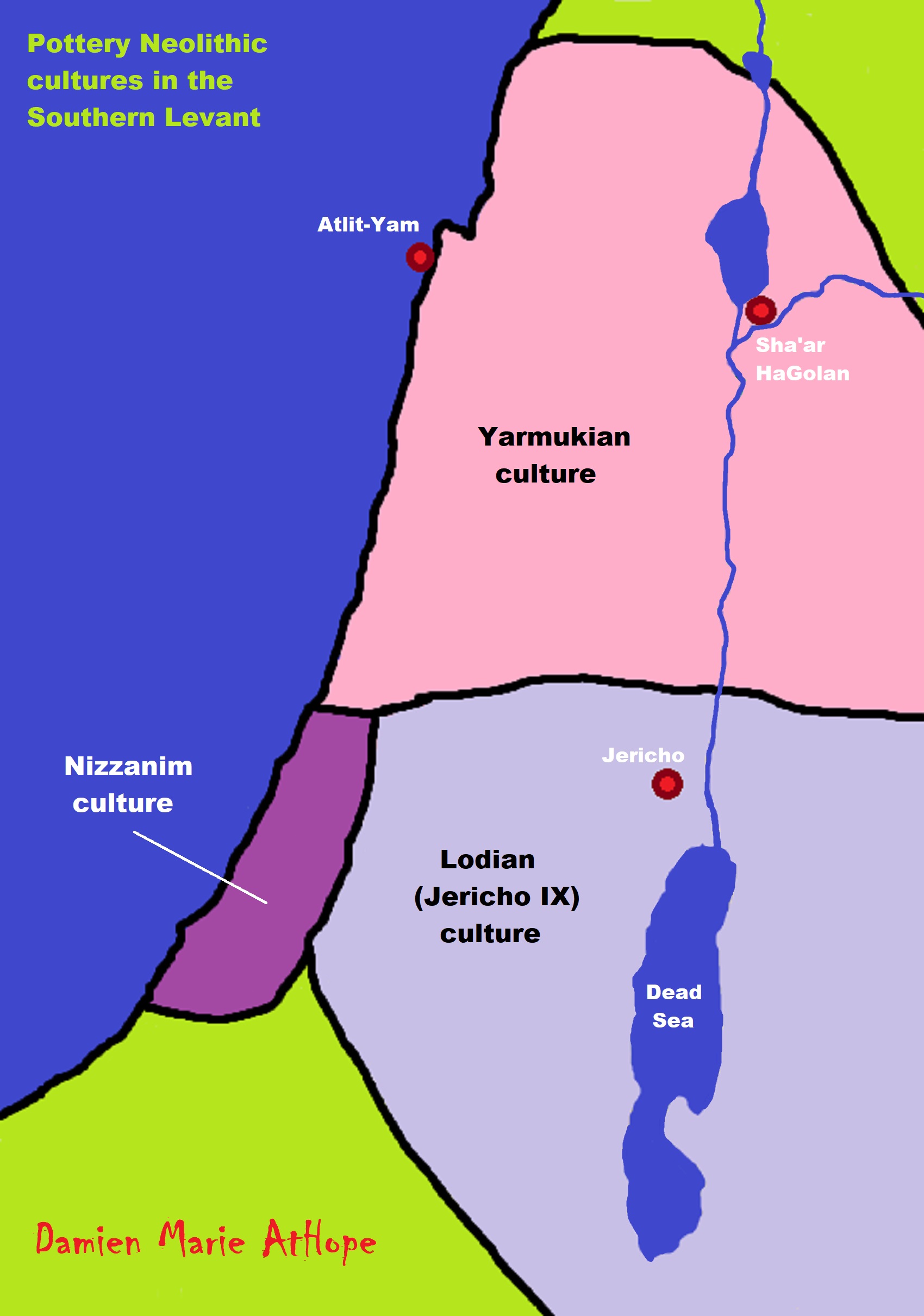

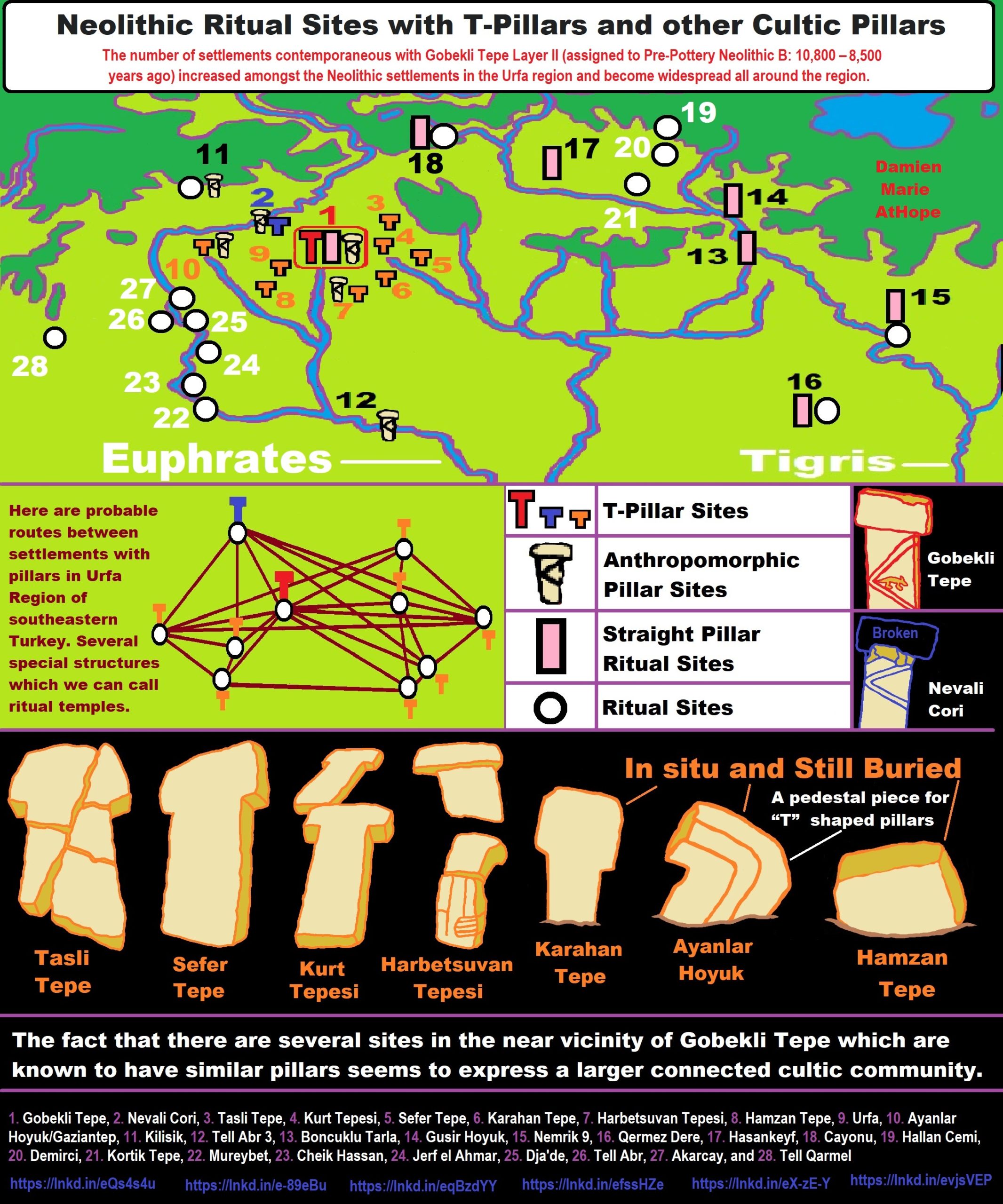
The number of settlements contemporaneous with Gobekli Tepe Layer II (assigned to Pre-Pottery Neolithic B: 10,800 – 8,500 years ago) increased amongst the Neolithic settlements in the Urfa region and become widespread all around the region.
- Gobekli Tepe, 2. Nevali Cori, 3. Tasli Tepe, 4. Kurt Tepesi, 5. Sefer Tepe, 6. Karahan Tepe, 7. Harbetsuvan Tepesi, 8. Hamzan Tepe, 9. Urfa, 10. Ayanlar Hoyuk/Gaziantep, 11. Kilisik, 12. Tell Abr 3, 13. Boncuklu Tarla, 14. Gusir Hoyuk, 15. Nemrik 9, 16. Qermez Dere, 17. Hasankeyf, 18. Cayonu, 19. Hallan Cemi, 20. Demirci, 21. Kortik Tepe, 22. Mureybet, 23. Cheik Hassan, 24. Jerf el Ahmar, 25. Dja’de, 26. Tell Abr, 27. Akarcay, and 28. Tell Qarmel
Göbekli Tepe is not alone, in fact, it is part of a religious/cultural connected ritual culture in the general region. There are several other similar sites with similar T-pillars to Göbekli Tepe or other types of stone pillar providing a seeming connected cult belief or religious culture of pillars seen in the PPNA-PPNB in the northern portion of the Near East.
“The locations of the sites that contain “T” shaped pillars are the main topic that needs more understanding to grasp the larger sociocultural-religious cultural complex in the same general region. Another matter under discussion is to comprehend the differences between the small-scale settlements that contain cult centers and “T” shaped pillars and the larger ones found at Gobekli Tepe layer III. The fact that settlements with “T” shaped pillars contain both the remains of circular domestic buildings and the pillars such as seen at Cayonu and Nevali Cori, which are also known to contain cult and domestic buildings. It is contemplated that such settlements are contemporary with Gobekli Tepe layer II and the cult building known from Nevali Cori based on the similarities and differences of the “T” shaped pillars. In the light of the finds unearthed from the settlements in Şanliurfa region that contain “T” shaped pillars, such settlements should be dated to the end of Late Pre-Pottery Neolithic A (LPPNA) and the Early Pre-Pottery Neolithic B (EPPNB).” ref
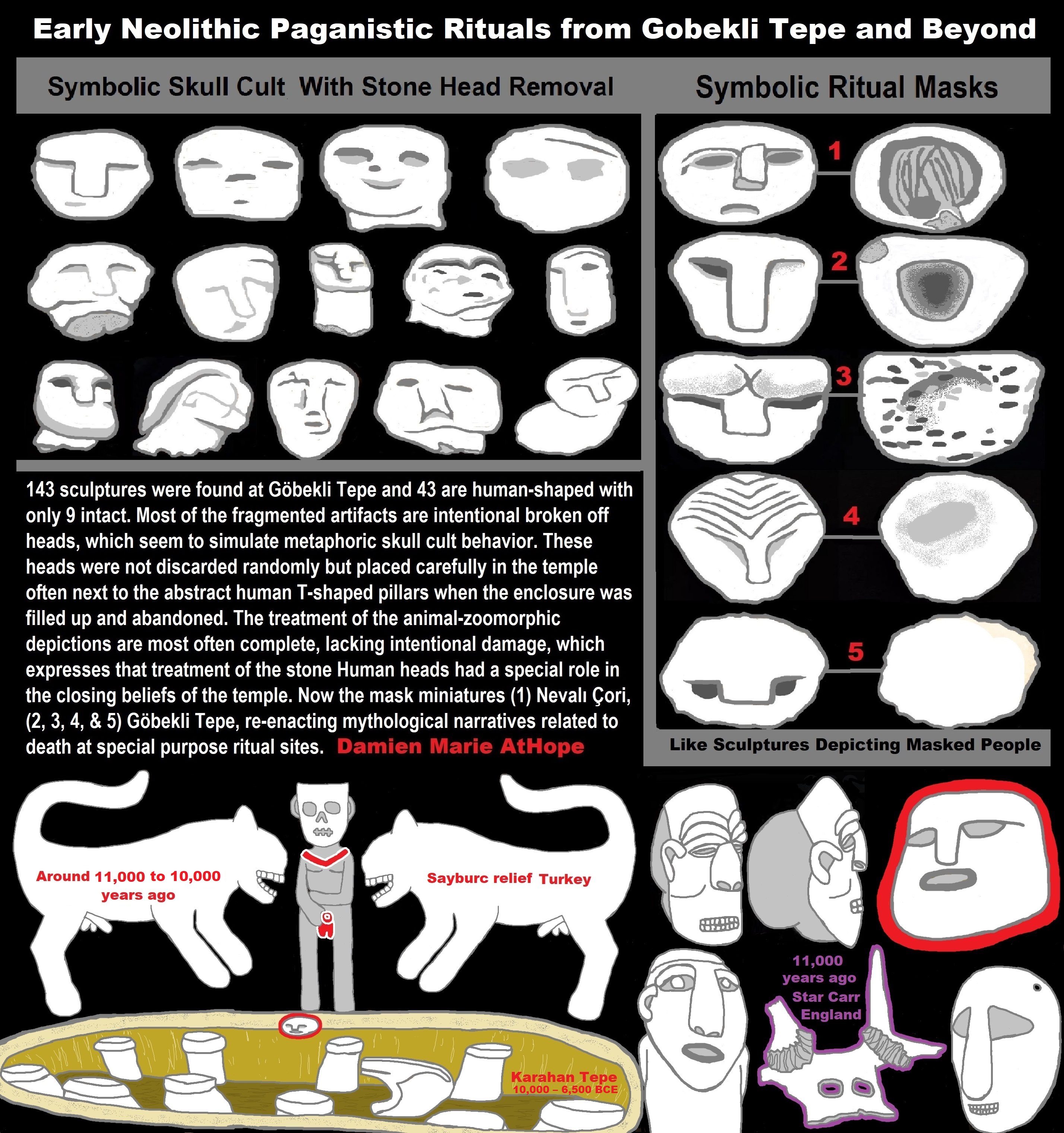
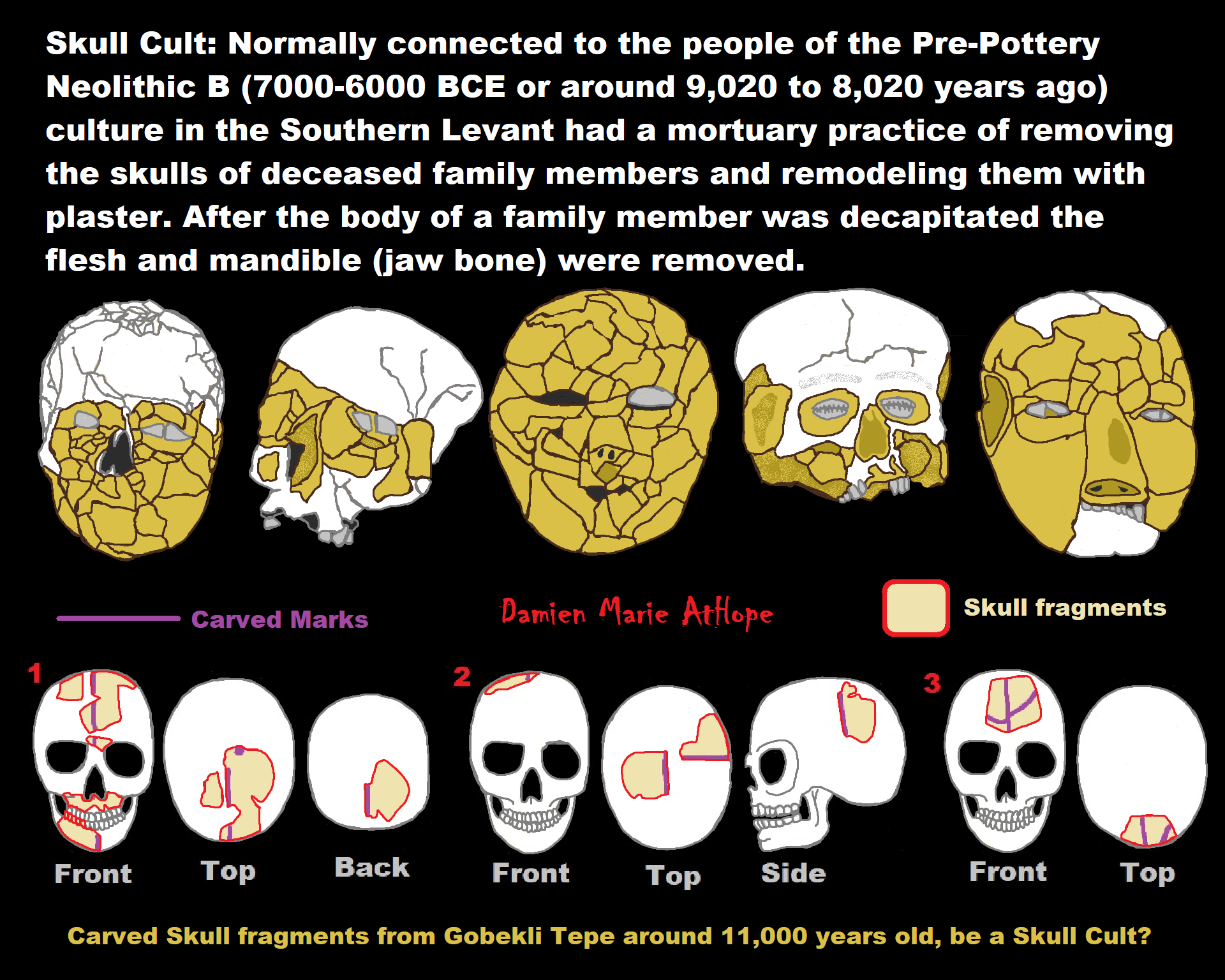
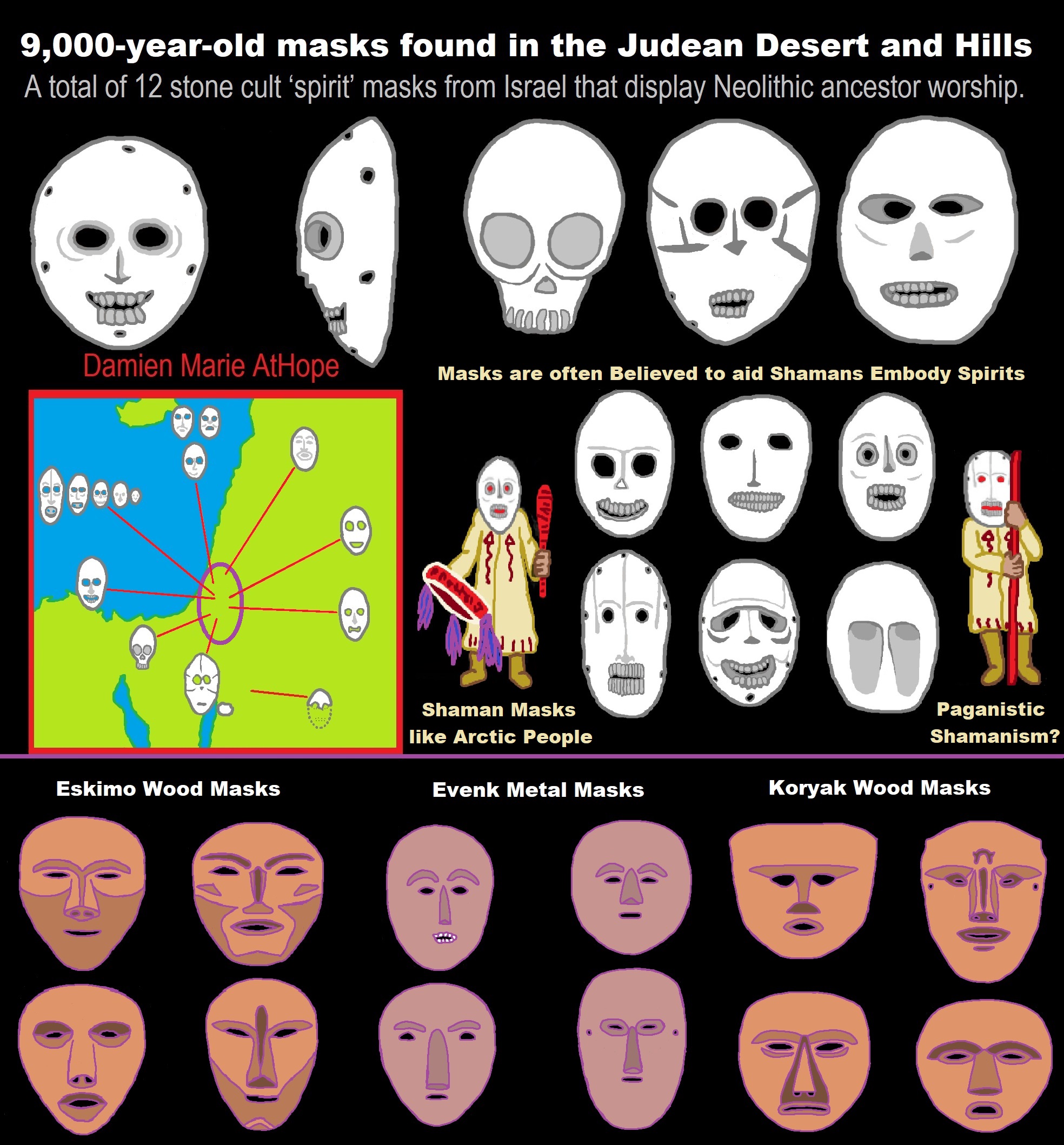

BEHEADED ANCESTORS. OF SKULLS AND STATUES IN PRE-POTTERY
Pre-pottery Neolithic “Skull Cult/Ancestor Cult” Sites in the Levant and Predominant in Israel
Info on the listed sites:
*Beisamoun: Link
*El-Wad: Link
*Ghwair: Link, Link, Link, Link
*Hatula: Link
*Kfar Hahoresh: Link
*Khirbet Hammam: Link, Link, Link
*Mallaha: Link
*Munhata: Link
*Nahal Hemar: Link, Link, Link
*Tell Aswad: Link
*Tell Ramad: Link
*Wadi Shu’eib: Link, Link, Link
“In the Levant, plastered and remodeled skulls have been found in several PPNB sites, such as Jericho, Tell Ramad, Beisamoun, Kfar Hahoresh, Tell-Aswad, ‘Ain Ghazal, and Nahal Hemar and are thus considered part of a mortuary practice typical of the PPNB. This practice seems to have continued in Anatolia, as plastered skulls have been found at Köşk Höyük [ref]–[ref] and Çatal Hüyük [ref] in much later PN contexts. It is still unclear how the central Anatolian plastered skulls relate to those of the Levant, when there are none of such plastered skulls in Anatolia during the PPNB, and none in the Levant during the PN.” ref
“In the Levant, planned burial customs, performed for ritualistic purposes, date as far back as the Middle Paleolithic [ref]. Skull-related funerary practices began during the late and the final Natufian of the southern Levant (12,500–11,800 tears ago), as evidenced in the Hayonim Cave and Eynan sites, where skulls were detached from the rest of the skeleton [ref]. In PPNA Jericho, group burials of isolated unadorned skulls (nested skulls), organized in various configurations, have been found. The same phenomenon was reported in the EPPNB site of Motza [ref]. During the Mid-late PPNB, mortuary customs developed, involving the artificial remodeling of skulls, evidence of which has been found across the Near East. Skulls covered by plaster masks have been located in Jericho, Beisamoun [ref], ‘Ain Ghazal [ref], [ref], Kfar Hahoresh [ref], Tell Ramad [ref]–[ref], and Tell Aswad [ref]. Three plastered facial masks, without the human skulls, were found buried together in a pit at ‘Ain Ghazal [ref]. At Nahal Hemar, three skulls ornamented with asphalt motifs and one burned skull were found [ref], [ref].” ref
“In Ujrat el Mehed (southern Sinai), adult skulls were removed from the post-cranial skeleton, similarly to other Neolithic Levantine sites [ref]. Other special remains include a skull painted with red ochre from Tell Abu Hureyra [ref], a skull decorated with red and black substances from ‘Ain Ghazal [ref] and painted stone masks from Nahal Hemar [ref]and the area of Er-Ram (exact provenance unknown) [ref]. Thus, the three plastered skulls uncovered at Yiftahel join a growing record of artificially treated skulls from the Levantine PPNB. Most of the plastered skulls found to date belong to adult individuals, and both sexes are represented. For our case, it is important to note that the PPNB is characterized by the shift from hunter-gatherer groups to agricultural societies. This process took place on many different levels, e.g., demographic, societal, religious, economic and epidemiological levels [ref]–[ref].” ref
“It is difficult to draw interpretation from these finds but clearly show the first appearance and gradual affirmation of skulls separation, with special reference to individuals and preserving individual identities. Evidence has shown how facial recognition is a major issue for establishing any kind of personal and social relationships. The memory of dead persons and, furthermore, materializing their identities by means of their skulls was the first step to give them an “after death” life (afterlife ancestor worship) to be oriented towards the ideological needs of the new agricultural society.” ref
“The planners and builders of Gobeklitepe still remain a big mystery, and no one has been able to crack the code so far. It is also surmised that Gobeklitepe’s main function was primarily ritual burials, and in some lesser capacity big feasts and social gatherings. In human terms it is roughly estimated that a minimum of 500 bodies might pull it off.Archaeologists believe that the tail end of Hunter- Gatherer societies were organized in a shamanic way, suggesting that some individuals among them were more developed, a solid system and a sound hierarchy and as such became religious leaders, who presided over – and organized – their clans and societies seemingly a level of priest/priestess-hood, as seen in paganism.” ref
“Skull cult can take on different forms, that is, with skull modifications frequently underlying very specific cultural codes. In the Pre-Pottery Neolithic (PPN; 9600–7000 calBC) of Southeast Anatolia and the Levant, there is an abundance of archaeological evidence for the special status assigned to the human skull: In addition to the deposition of skulls in special places, as attested by the “skull depot” at Tell Qaramel or the “skull building” at Çayönü, human skulls are also known to have been decorated, for example, where the soft tissue and facial features have been remodeled in plaster and/or color was applied to the bone.” ref
“A hitherto unknown type of skull modification has recently been observed at Göbekli Tepe in Southeast Anatolia. And although human burials are still absent from Göbekli Tepe, a considerable number of fragmented human bones (n = 691) have been recovered. Notably, most of the human bone fragments (n = 408) stem from the skull, whereas postcranial fragments are less frequent (n = 283). Although these statistics could reflect taphonomic processes at work, a positive selection of skull material could be indicated. A total of 40 skull fragments (9.8%) carry cut marks from defleshing activities; additional signs of skeletal processing (decapitation) are represented by cut marks on two (of just seven) cervical vertebrae so far discovered at the site.” ref
Wadi Raba Culture
“The Wadi Raba culture or Wadi Rabah culture is a Pottery Neolithic archaeological culture of the Southern Levant, dating to the middle of the 5th millennium BCE. This period was first identified at the ancient site of Jericho (Tell es-Sultan) by British archaeologists John Garstang and Kathleen Kenyon in separate excavations. Kenyon has named this period in Jericho “Pottery Neolithic B”. The name “Wadi Rabah” was since used in archaeologic literature thanks to the works of Israeli archaeologist Jacob Kaplan in the site of Wadi Rabah. This culture is known from a small number of sites, in some of which remains of small rectangular structures were discovered. Some larger structures were found in Munhata, Wadi Rabah, and Ein el-Jarba, though Israeli archaeologist Yosef Garfinkel suggests that large courtyard structures were erected in that period, like the ones found at Sha’ar HaGolan of the preceding Yarmukian culture (c. 6400–6000 BCE) and Tel Tsaf of the following Early/Middle Chalcolithic period (c. 5300–4500 BCE).” ref
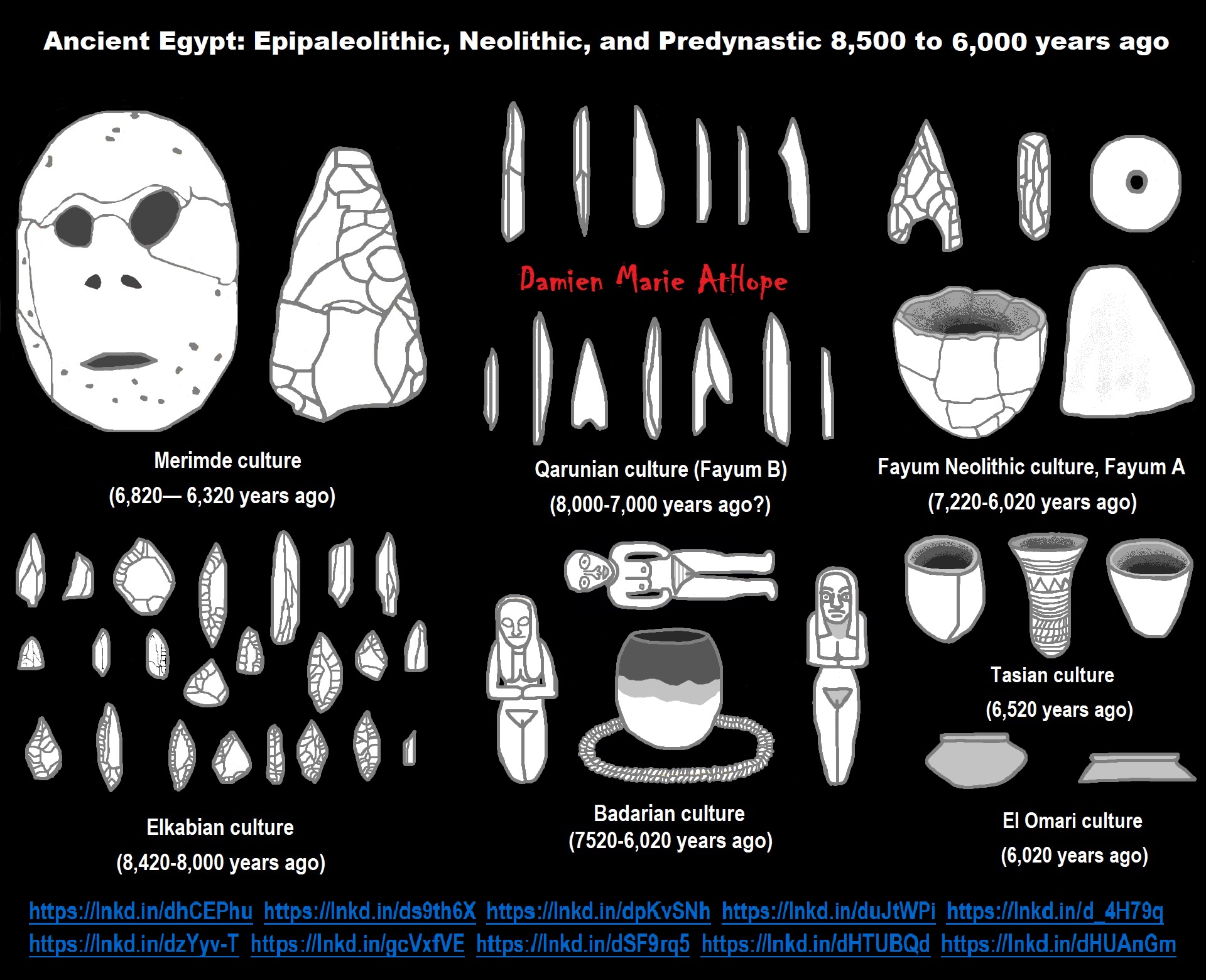
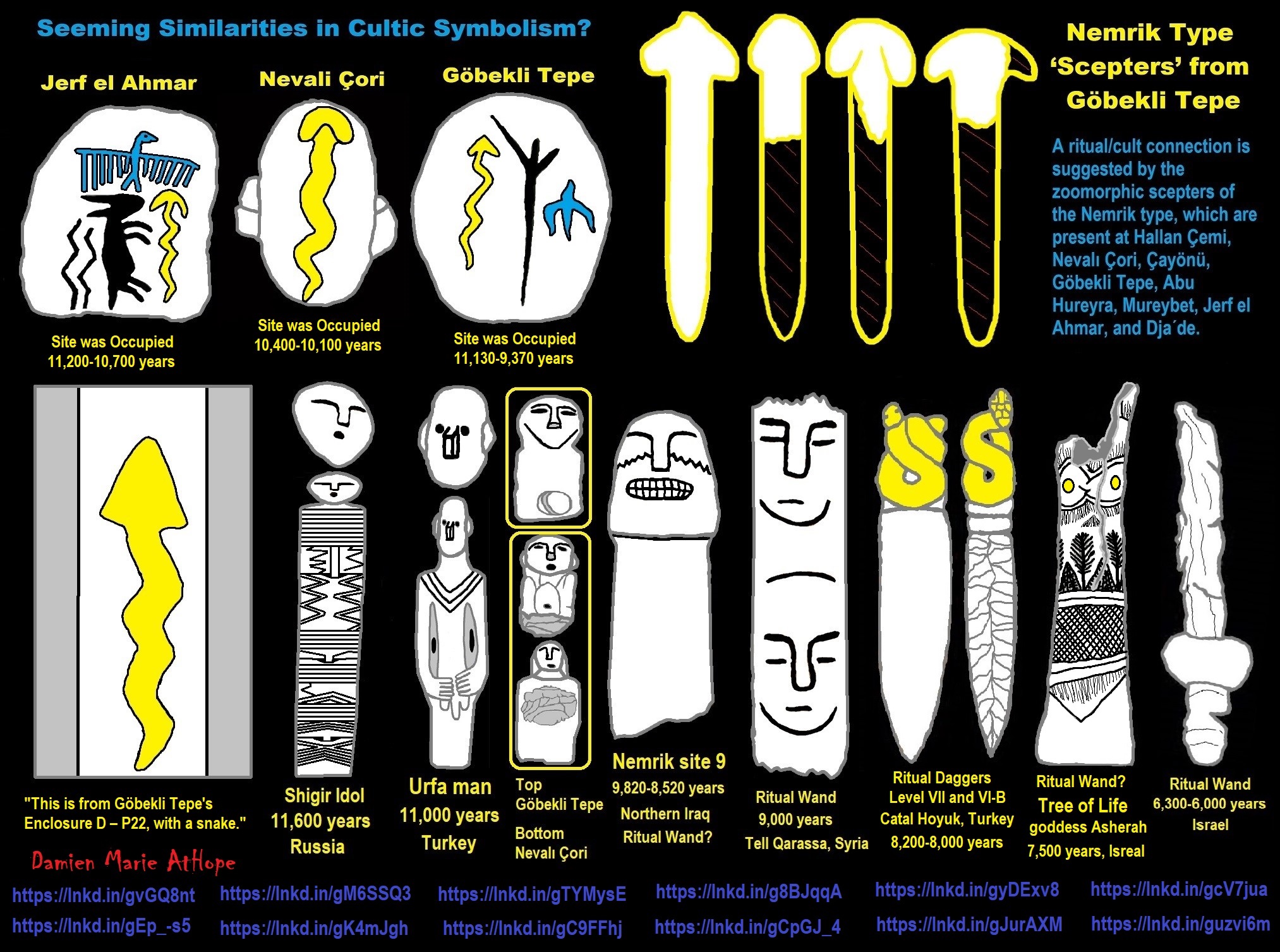
ref, ref, ref, ref, ref, ref, ref, ref, ref, ref, ref, ref
The artifact second from the bottom right (Ritual Wand: Tree of Life goddess): “Bone figurine from Neveh Yam”
Neve Yam
“Neve Yam (Hebrew: נְוֵה יָם, lit. Sea Oasis) is a kibbutz in northern Israel. Located around twenty kilometers south of Haifa.” ref
Tree of Life Goddess
“This 7,500 year-old goddess figurine from Neve Yam is among the world’s earliest evidence for established religion, the origins of which date back to the agricultural revolution, around 10,000 years ago. It is similar to contemporaneous figurines, especially the one discovered at Hagosherim, some 100 km away. The striking resemblance between the two objects indicates that the cult of the goddess was widespread by this time. In later periods, the combination of a plant motif (the Tree of Life) with the image of a woman (the goddess) became a common image throughout the Ancient Near East, where it represented the goddess Asherah. Figurine of a goddess decorated with palm fronds or stalks of grain. Neve Yam, Wadi Rabah culture, Late Neolithic Period, 7,500 years ago, incised bone is from the Collection of Israel Antiquities Authority.” ref
Symbolic artifacts from the submerged Neolithic village of Neve-Yam and contemporaneous Israeli sites as fossil directeur for the Wadi Rabah culture.
ABSTRACT: Four symbolic artifacts were recovered from the Late Neolithic/Early Chalcolithic (Wadi Rabah culture) site of Neveh Yam, dated to the sixth–fifth millennia BCE. These comprise two anthropomorphic figurines made of stone, one anthropomorphic image incised on bone, and a sherd with zoomorphic incisions. These artifacts are described and discussed with reference to similar objects found in additional Late Neolithic/Early Chalcolithic sites in the southern Levant and later sites in Mesopotamia, the Aegean, and the Iberian Peninsula. It is proposed that the bone figurines from Neveh Yam, ªEn ¥ippori and Ha-Gosherim could represent a symbolic marker for the Wadi Rabah culture and contemporary cultures in the southern Levant.” ref
Excavations at the Submerged Neolithic site of Atlit Yam, off the Carmel Coast of Israel
“Underwater archaeology in Israel began in 1960 and, already then, traces of submerged settlements were discovered. The first research took place in 1969, when the Neve-Yam site was exposed by a winter storm. Subsequently, during the early 1980s, a research project aimed at locating, excavating, salvage, and research of submerged prehistoric settlements. Six decades of research has revealed 17 submerged prehistoric sites, containing substantial and well-preserved finds that enlighten the culture and subsistence of the prehistoric coastal populations of the region. Among them are thirteen Neolithic sites, belonging to the Pre-Pottery Neolithic C period, represented at the site of Atlit-Yam, and twelve Pottery Neolithic sites dated to between 8000 and 6500 cal. BP. Most of the PN sites (Kfar-Samir; Hishuley Carmel; Kfar-Galim; Nahal Galim; Hahoterim; Tel-Hreiz; Megadim; Atlit north bay; Neve-Yam and Habonim) are attributed to the Wadi Rabah culture, considered as late Pottery Neolithic or early Chalcolithic, while the Neve-Yam North site belongs to the Lodian culture, which predates the Wadi Rabah culture. The Pottery Neolithic sites are located close to the present shore (1–200 m offshore) at depths of 0–5 m, while the older Atlit-Yam site is located further offshore (200–400 m) and in deeper water (8–12 m below sea level).” ref
The archaeology and paleoenvironment of the submerged Pottery Neolithic settlement of Kfar Samir (Israel).
Abstract: “This article focuses on a recently excavated stone and wood-built water well (Well no.13) from the submerged Pottery Neolithic site (Wadi Rabah culture) of Kfar Samir on the Carmel coast, Israel. This feature is considered within the context of previous research on the site and other submerged sites in the same area, incorporating new data on botanical remains and radiometric dates from Kfar Samir. Taken together, the new and previous investigations of the site shed light on the lifestyle of Pottery Neolithic coastal populations in the Southern Levant, especially those relating to the management of water resources, olive oil production, and the evolution of Mediterranean foodways. This research further informs us on the palaeoenvironment of the Carmel coast and sea-level changes.” ref


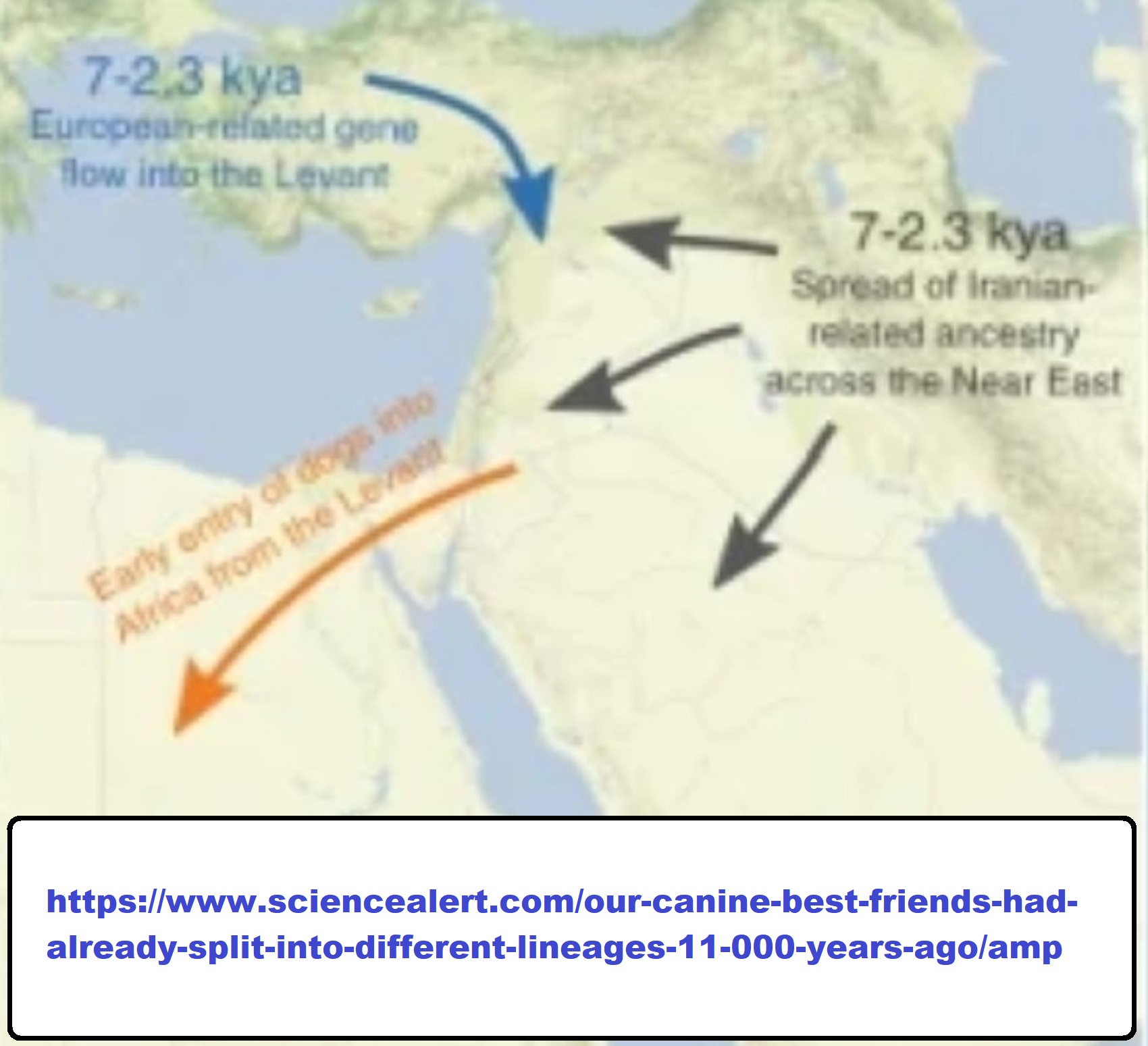
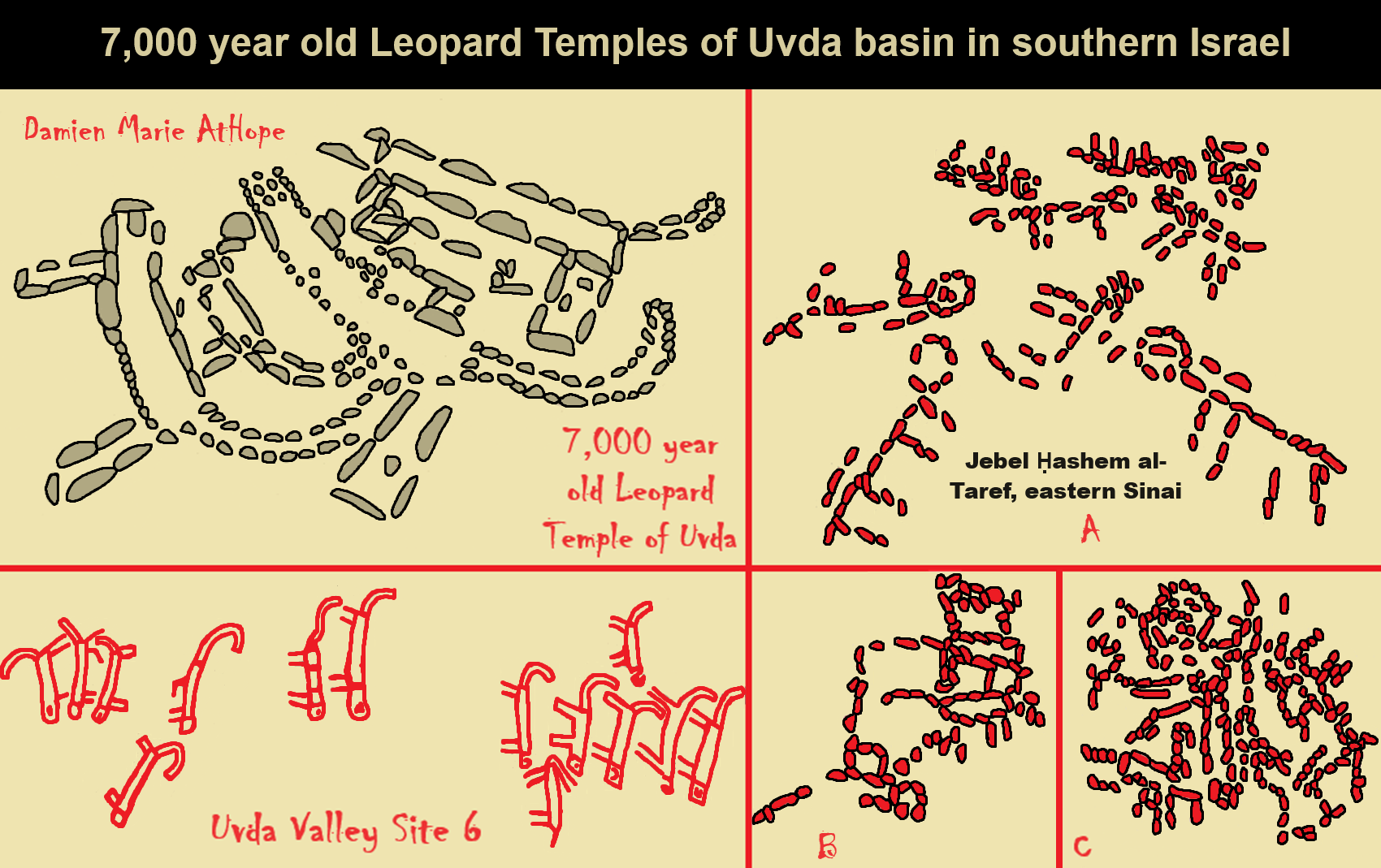
7,000-year-old Leopard Temples of Uvda basin in southern Israel
The 7,000 year old Masseboth Leopard Temple of Uvda
“7,000-year-old Leopard Temple of Uvda, in the Uvda basin in the desert of southern Israel. Uvda (Hebrew: עובדה) is the name of a region in the southern Negev desert, directly north of Eilat. The name derives from the Hebrew word uvda (meaning fact). The Uvda Valley is known for the 7000-year-old Leopard Temple archaeological site. They also began to worship something, perhaps the sun, perhaps their own ancestors, and intriguingly, perhaps the local scourge, the wild leopard.” ref, ref
“Uvda Valley Site 6, “stone drawings” of 15 leopards and one oryx, next to an open-air sanctuary, a vertical view (small stones indicate reconstruction).” ref
“Jebel Ḥashem al-Taref, eastern Sinai, three examples of “stone drawings” built next to pairs of open-air sanctuaries: (a) Excavated; (b,c) Unexcavated, dark stones—vertically set, light stones—fallen. Radiometric dates available to date from open sanctuaries are of the 6th and 5th millennia BCE. Nevertheless, Pre-Pottery Neolithic B flint items were also found in some of them (8th–7th millennia BCE), while other finds indicate continuation through the third millennium BCE, even the early second (Middle Bronze Age).” ref
“All open sanctuaries were built next to ancient roads (Figure 21c and Figure 27), while clusters of sanctuaries were built next to road junctions, for example, a cluster of 33 open sanctuaries near Jebel Ḥashem al-Taref in Sinai, 35 km west of Eilat; 4 pairs of sanctuaries at Ramat Saharonim; and 28 sanctuaries near Har Tzuriʻaz, in the southern Negev. Some sanctuaries were built in burial sites, also located next to ancient roads and road junctions.” ref
“This is also the female’s position in the drawing of a couple from Kuntilat ʻAjrud (Figure 17), slightly behind the male, presented as standing on a higher-like level, and her right leg is hidden behind the male’s left leg. Many open sanctuaries are circular, (Figure 21, Figure 28, and Figure 33). Most of them are 6–18 m in diameter, but tiny circular sanctuaries are also known, ca. 3 m in diameter (Figure 33), as well as large circular cult enclosures up to 70 m in diameter (Figure 33b). Stone alignments are attached to most of the circular sanctuaries, mainly in the form of “ladders,” which are chains of square cells made of a single line of stones or of small flagstones set vertically into the ground (Figure 34 and Figure 36). Their length ranges from a few meters to 78 m, and they present one of the combination of lines and circles.” ref
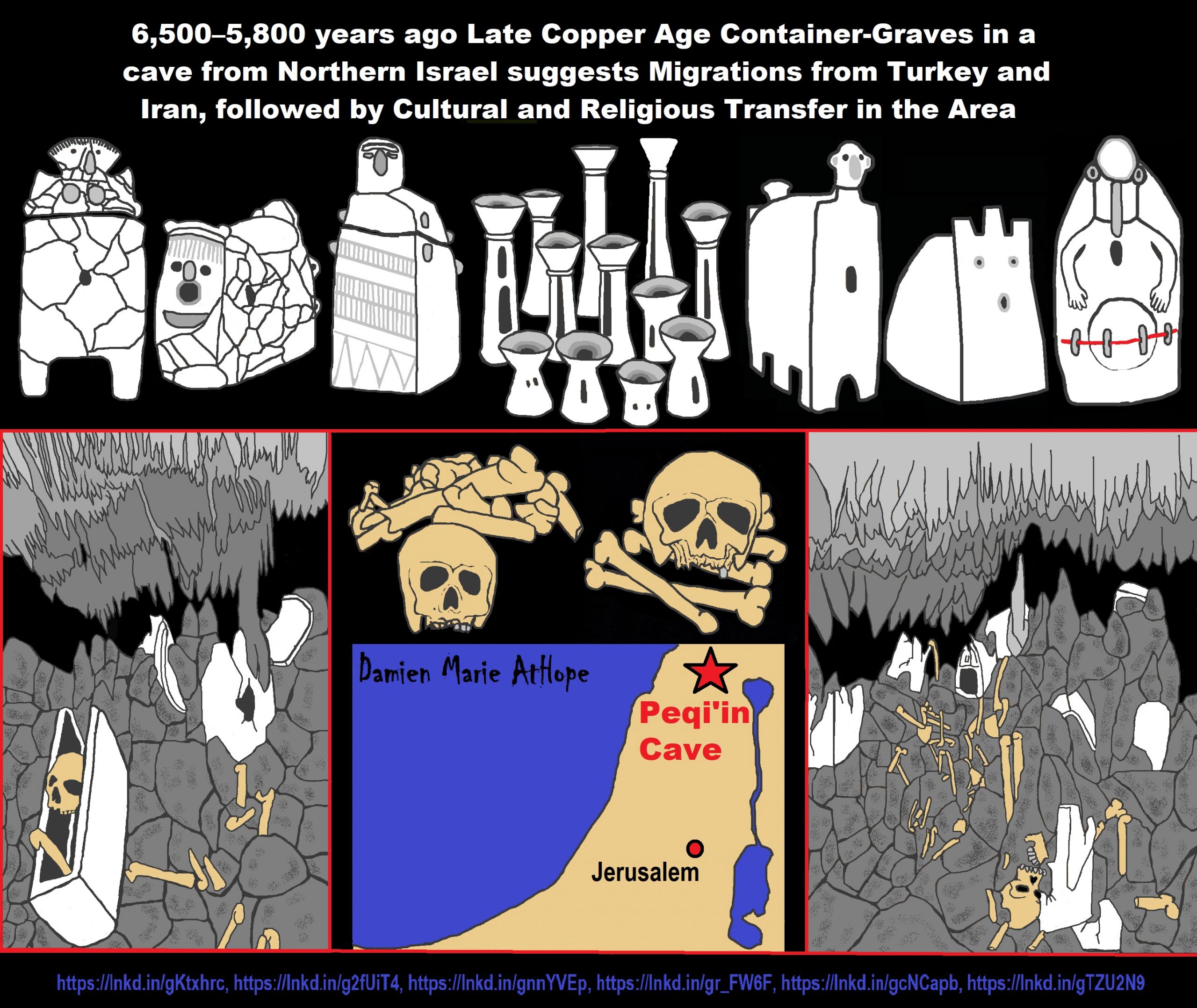
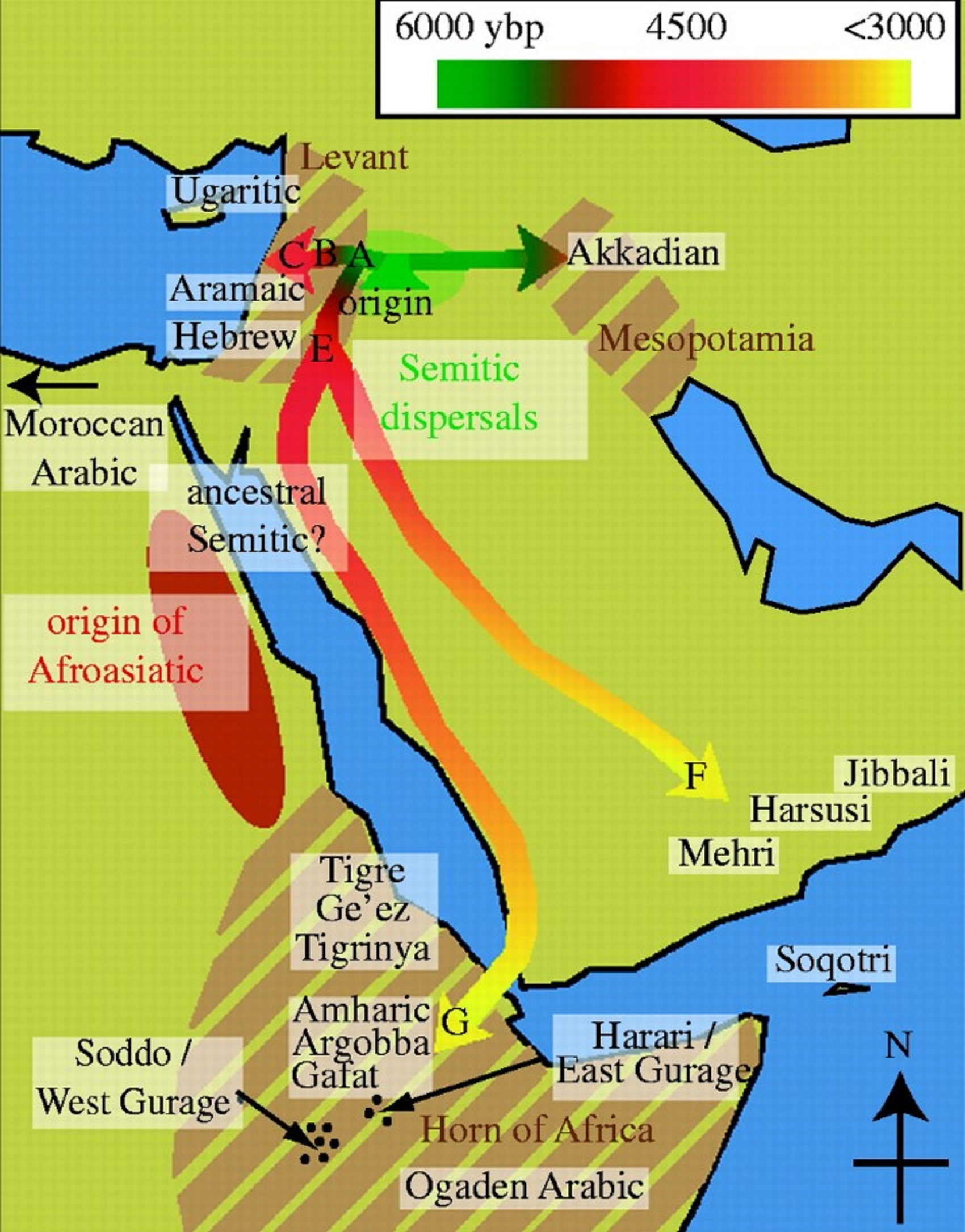
Proto-Semitic dates to ca. 4500–3500 BCE or around 6,500 to 5,500 years ago.
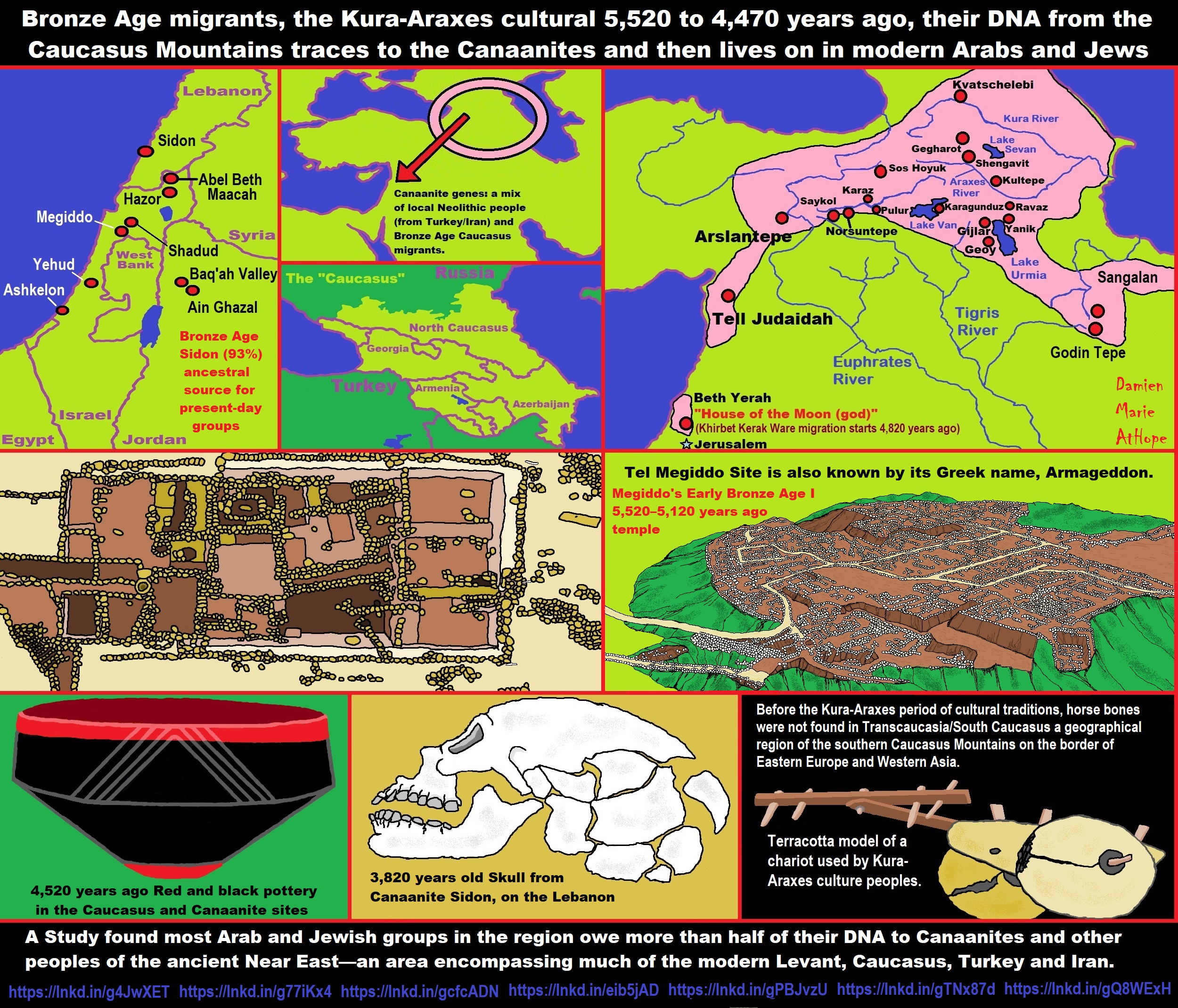
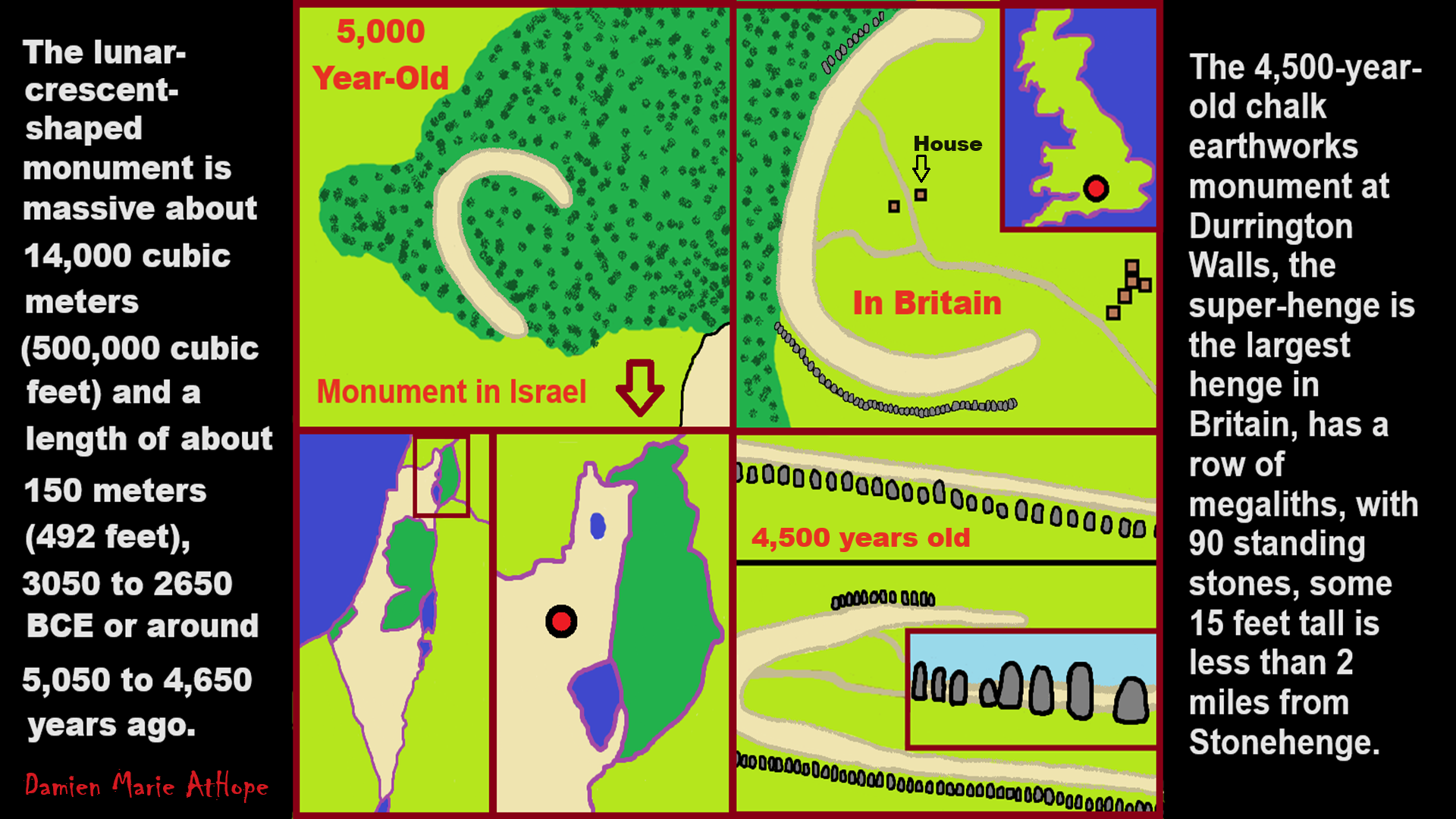
The lunar-crescent-shaped monument is massive at about 14,000 cubic meters (500,000 cubic feet) and has a length of about 150 meters (492 feet), 3050 to 2650 BCE, or around 5,050 to 4,650 years ago.
The 4,500-year-old chalk earthworks monument at Durrington Walls, the super-henge is the largest henge in Britain, has a row of megaliths, with 90 standing stones, some 15 feet tall, is less than 2 miles from Stonehenge.
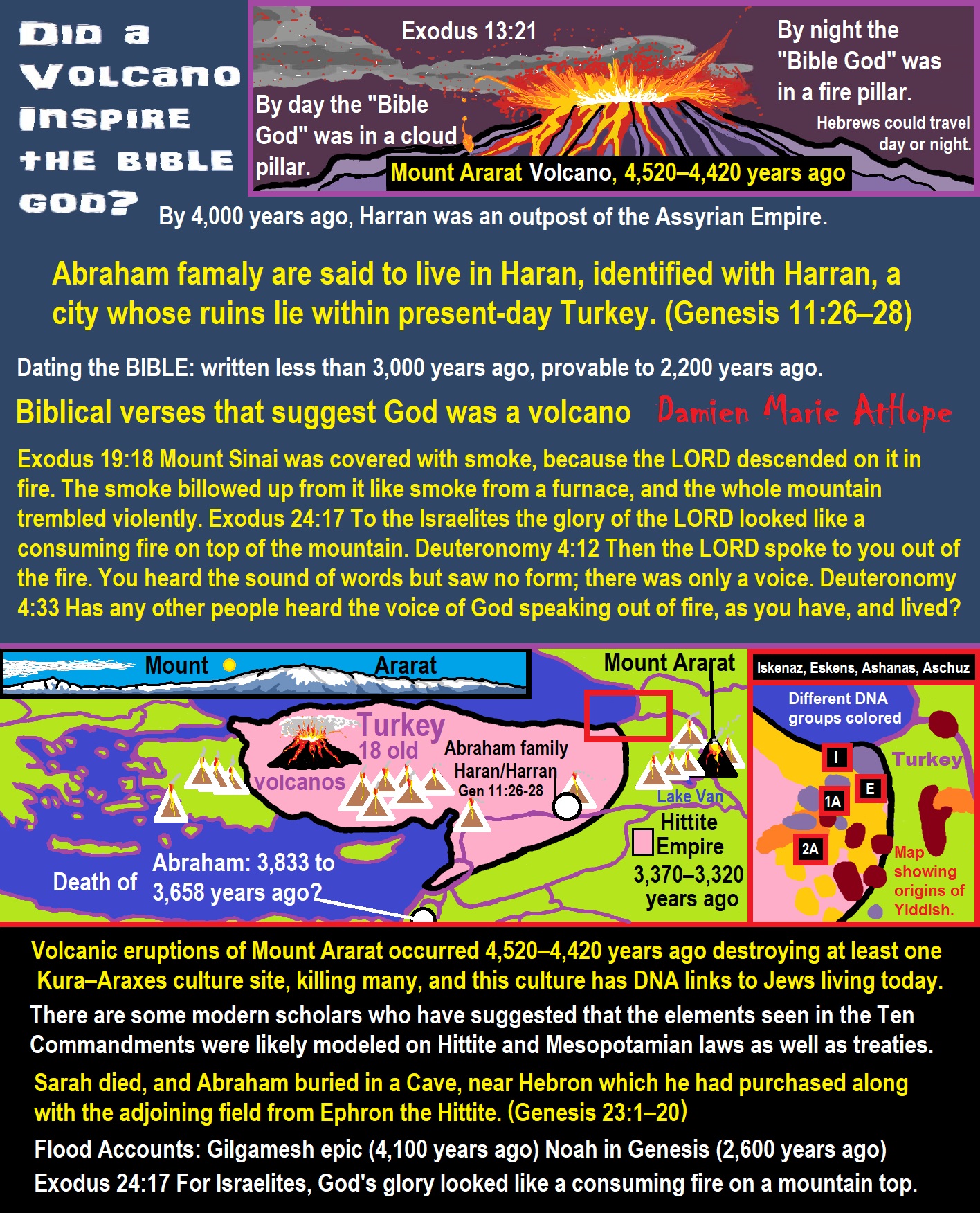
ref, ref, ref, ref, ref, ref, ref, ref, ref, ref, ref, ref, ref
By day the LORD went ahead of them in a pillar of cloud to guide them on their way and by night in a pillar of fire to give them light, so that they could travel by day or night.
- By day the “Bible God” was in a cloud pillar.
- By night the “Bible God” was in a fire pillar.


People don’t commonly teach religious history, even that of their own claimed religion. No, rather they teach a limited “pro their religion” history of their religion from a religious perspective favorable to the religion of choice.

Do you truly think “Religious Belief” is only a matter of some personal choice?
Do you not see how coercive one’s world of choice is limited to the obvious hereditary belief, in most religious choices available to the child of religious parents or caregivers? Religion is more commonly like a family, culture, society, etc. available belief that limits the belief choices of the child and that is when “Religious Belief” is not only a matter of some personal choice and when it becomes hereditary faith, not because of the quality of its alleged facts or proposed truths but because everyone else important to the child believes similarly so they do as well simply mimicking authority beliefs handed to them. Because children are raised in religion rather than being presented all possible choices but rather one limited dogmatic brand of “Religious Belief” where children only have a choice of following the belief as instructed, and then personally claim the faith hereditary belief seen in the confirming to the belief they have held themselves all their lives. This is obvious in statements asked and answered by children claiming a faith they barely understand but they do understand that their family believes “this or that” faith, so they feel obligated to believe it too. While I do agree that “Religious Belief” should only be a matter of some personal choice, it rarely is… End Hereditary Religion!

Animism: Respecting the Living World by Graham Harvey
“How have human cultures engaged with and thought about animals, plants, rocks, clouds, and other elements in their natural surroundings? Do animals and other natural objects have a spirit or soul? What is their relationship to humans? In this new study, Graham Harvey explores current and past animistic beliefs and practices of Native Americans, Maori, Aboriginal Australians, and eco-pagans. He considers the varieties of animism found in these cultures as well as their shared desire to live respectfully within larger natural communities. Drawing on his extensive casework, Harvey also considers the linguistic, performative, ecological, and activist implications of these different animisms.” ref

We are like believing machines we vacuum up ideas, like Velcro sticks to almost everything. We accumulate beliefs that we allow to negatively influence our lives, often without realizing it. Our willingness must be to alter skewed beliefs that impend our balance or reason, which allows us to achieve new positive thinking and accurate outcomes.

My thoughts on Religion Evolution with external links for more info:
- (Pre-Animism Africa mainly, but also Europe, and Asia at least 300,000 years ago), (Pre-Animism – Oxford Dictionaries)
- (Animism Africa around 100,000 years ago), (Animism – Britannica.com)
- (Totemism Europe around 50,000 years ago), (Totemism – Anthropology)
- (Shamanism Siberia around 30,000 years ago), (Shamanism – Britannica.com)
- (Paganism Turkey around 12,000 years ago), (Paganism – BBC Religion)
- (Progressed Organized Religion “Institutional Religion” Egypt around 5,000 years ago), (Ancient Egyptian Religion – Britannica.com)
- (CURRENT “World” RELIGIONS after 4,000 years ago) (Origin of Major Religions – Sacred Texts)
- (Early Atheistic Doubting at least by 2,600 years ago) (History of Atheism – Wikipedia)
“Religion is an Evolved Product” and Yes, Religion is Like Fear Given Wings…
Atheists talk about gods and religions for the same reason doctors talk about cancer, they are looking for a cure, or a firefighter talks about fires because they burn people and they care to stop them. We atheists too often feel a need to help the victims of mental slavery, held in the bondage that is the false beliefs of gods and the conspiracy theories of reality found in religions.
Understanding Religion Evolution:
- Pre-Animism (at least 300,000 years ago)
- Animism (Africa: 100,000 years ago)
- Totemism (Europe: 50,000 years ago)
- Shamanism (Siberia: 30,000 years ago)
- Paganism (Turkey: 12,000 years ago)
- Progressed organized religion (Egypt: 5,000 years ago), (Egypt, the First Dynasty 5,150 years ago)
- CURRENT “World” RELIGIONS (after 4,000 years ago)
- Early Atheistic Doubting (at least by 2,600 years ago)
“An Archaeological/Anthropological Understanding of Religion Evolution”
It seems ancient peoples had to survived amazing threats in a “dangerous universe (by superstition perceived as good and evil),” and human “immorality or imperfection of the soul” which was thought to affect the still living, leading to ancestor worship. This ancestor worship presumably led to the belief in supernatural beings, and then some of these were turned into the belief in gods. This feeble myth called gods were just a human conceived “made from nothing into something over and over, changing, again and again, taking on more as they evolve, all the while they are thought to be special,” but it is just supernatural animistic spirit-belief perceived as sacred.
Quick Evolution of Religion?
Pre-Animism (at least 300,000 years ago) pre-religion is a beginning that evolves into later Animism. So, Religion as we think of it, to me, all starts in a general way with Animism (Africa: 100,000 years ago) (theoretical belief in supernatural powers/spirits), then this is physically expressed in or with Totemism (Europe: 50,000 years ago) (theoretical belief in mythical relationship with powers/spirits through a totem item), which then enlists a full-time specific person to do this worship and believed interacting Shamanism (Siberia/Russia: 30,000 years ago) (theoretical belief in access and influence with spirits through ritual), and then there is the further employment of myths and gods added to all the above giving you Paganism (Turkey: 12,000 years ago) (often a lot more nature-based than most current top world religions, thus hinting to their close link to more ancient religious thinking it stems from). My hypothesis is expressed with an explanation of the building of a theatrical house (modern religions development). Progressed organized religion (Egypt: 5,000 years ago) with CURRENT “World” RELIGIONS (after 4,000 years ago).
Historically, in large city-state societies (such as Egypt or Iraq) starting around 5,000 years ago culminated to make religion something kind of new, a sociocultural-governmental-religious monarchy, where all or at least many of the people of such large city-state societies seem familiar with and committed to the existence of “religion” as the integrated life identity package of control dynamics with a fixed closed magical doctrine, but this juggernaut integrated religion identity package of Dogmatic-Propaganda certainly did not exist or if developed to an extent it was highly limited in most smaller prehistoric societies as they seem to lack most of the strong control dynamics with a fixed closed magical doctrine (magical beliefs could be at times be added or removed). Many people just want to see developed religious dynamics everywhere even if it is not. Instead, all that is found is largely fragments until the domestication of religion.
Religions, as we think of them today, are a new fad, even if they go back to around 6,000 years in the timeline of human existence, this amounts to almost nothing when seen in the long slow evolution of religion at least around 70,000 years ago with one of the oldest ritual worship. Stone Snake of South Africa: “first human worship” 70,000 years ago. This message of how religion and gods among them are clearly a man-made thing that was developed slowly as it was invented and then implemented peace by peace discrediting them all. Which seems to be a simple point some are just not grasping how devastating to any claims of truth when we can see the lie clearly in the archeological sites.
I wish people fought as hard for the actual values as they fight for the group/clan names political or otherwise they think support values. Every amount spent on war is theft to children in need of food or the homeless kept from shelter.
Here are several of my blog posts on history:
- To Find Truth You Must First Look
- (Magdalenian/Iberomaurusian) Connections to the First Paganists of the early Neolithic Near East Dating from around 17,000 to 12,000 Years Ago
- Natufians: an Ancient People at the Origins of Agriculture and Sedentary Life
- Possible Clan Leader/Special “MALE” Ancestor Totem Poles At Least 13,500 years ago?
- Jewish People with DNA at least 13,200 years old, Judaism, and the Origins of Some of its Ideas
- Baltic Reindeer Hunters: Swiderian, Lyngby, Ahrensburgian, and Krasnosillya cultures 12,020 to 11,020 years ago are evidence of powerful migratory waves during the last 13,000 years and a genetic link to Saami and the Finno-Ugric peoples.
- The Rise of Inequality: patriarchy and state hierarchy inequality
- Fertile Crescent 12,500 – 9,500 Years Ago: fertility and death cult belief system?
- 12,400 – 11,700 Years Ago – Kortik Tepe (Turkey) Pre/early-Agriculture Cultic Ritualism
- Ritualistic Bird Symbolism at Gobekli Tepe and its “Ancestor Cult”
- Male-Homosexual (female-like) / Trans-woman (female) Seated Figurine from Gobekli Tepe
- Could a 12,000-year-old Bull Geoglyph at Göbekli Tepe relate to older Bull and Female Art 25,000 years ago and Later Goddess and the Bull cults like Catal Huyuk?
- Sedentism and the Creation of goddesses around 12,000 years ago as well as male gods after 7,000 years ago.
- Alcohol, where Agriculture and Religion Become one? Such as Gobekli Tepe’s Ritualistic use of Grain as Food and Ritual Drink
- Neolithic Ritual Sites with T-Pillars and other Cultic Pillars
- Paganism: Goddesses around 12,000 years ago then Male Gods after 7,000 years ago
- First Patriarchy: Split of Women’s Status around 12,000 years ago & First Hierarchy: fall of Women’s Status around 5,000 years ago.
- Natufians: an Ancient People at the Origins of Agriculture and Sedentary Life
- J DNA and the Spread of Agricultural Religion (paganism)
- Paganism: an approximately 12,000-year-old belief system
- Paganism 12,000 years old: related to “Anarchism and Socialism” (Pre-Capitalism)
- Shaman burial in Israel 12,000 years ago and the Shamanism Phenomena
- Need to Mythicized: gods and goddesses
- 12,000 – 7,000 Years Ago – Paleo-Indian Culture (The Americas)
- 12,000 – 2,000 Years Ago – Indigenous-Scandinavians (Nordic)
- Norse did not wear helmets with horns?
- Pre-Pottery Neolithic Skull Cult around 11,500 to 8,400 Years Ago?
- 10,400 – 10,100 Years Ago, in Turkey the Nevail Cori Religious Settlement
- 9,000-6,500 Years Old Submerged Pre-Pottery/Pottery Neolithic Ritual Settlements off Israel’s Coast
- Catal Huyuk “first religious designed city” around 9,500 to 7,700 years ago (Turkey)
- Cultic Hunting at Catal Huyuk “first religious designed city”
- Special Items and Art as well as Special Elite Burials at Catal Huyuk
- New Rituals and Violence with the appearance of Pottery and People?
- Haplogroup N and its related Uralic Languages and Cultures
- Ainu people, Sámi people, Native Americans, the Ancient North Eurasians, and Paganistic-Shamanism with Totemism
- Ideas, Technology and People from Turkey, Europe, to China and Back again 9,000 to 5,000 years ago?
- First Pottery of Europe and the Related Cultures
- 9,000 years old Neolithic Artifacts Judean Desert and Hills Israel
- 9,000-7,000 years-old Sex and Death Rituals: Cult Sites in Israel, Jordan, and the Sinai
- 9,000-8500 year old Horned Female shaman Bad Dürrenberg Germany
- Neolithic Jewelry and the Spread of Farming in Europe Emerging out of West Turkey
- 8,600-year-old Tortoise Shells in Neolithic graves in central China have Early Writing and Shamanism
- Swing of the Mace: the rise of Elite, Forced Authority, and Inequality begin to Emerge 8,500 years ago?
- Migrations and Changing Europeans Beginning around 8,000 Years Ago
- My “Steppe-Anatolian-Kurgan hypothesis” 8,000/7,000 years ago
- Around 8,000-year-old Shared Idea of the Mistress of Animals, “Ritual” Motif
- Pre-Columbian Red-Paint (red ochre) Maritime Archaic Culture 8,000-3,000 years ago
- 7,522-6,522 years ago Linear Pottery culture which I think relates to Arcane Capitalism’s origins
- Arcane Capitalism: Primitive socialism, Primitive capital, Private ownership, Means of production, Market capitalism, Class discrimination, and Petite bourgeoisie (smaller capitalists)
- 7,500-4,750 years old Ritualistic Cucuteni-Trypillian culture of Moldova, Romania, and Ukraine
- Roots of a changing early society 7,200-6,700 years ago Jordan and Israel
- Agriculture religion (Paganism) with farming reached Britain between about 7,000 to 6,500 or so years ago and seemingly expressed in things like Western Europe’s Long Barrows
- My Thoughts on Possible Migrations of “R” DNA and Proto-Indo-European?
- “Millet” Spreading from China 7,022 years ago to Europe and related Language may have Spread with it leading to Proto-Indo-European
- Proto-Indo-European (PIE), ancestor of Indo-European languages: DNA, Society, Language, and Mythology
- The Dnieper–Donets culture and Asian varieties of Millet from China to the Black Sea region of Europe by 7,022 years ago
- Kurgan 6,000 years ago/dolmens 7,000 years ago: funeral, ritual, and other?
- 7,020 to 6,020-year-old Proto-Indo-European Homeland of Urheimat or proposed home of their Language and Religion
- Ancient Megaliths: Kurgan, Ziggurat, Pyramid, Menhir, Trilithon, Dolman, Kromlech, and Kromlech of Trilithons
- The Mytheme of Ancient North Eurasian Sacred-Dog belief and similar motifs are found in Indo-European, Native American, and Siberian comparative mythology
- Elite Power Accumulation: Ancient Trade, Tokens, Writing, Wealth, Merchants, and Priest-Kings
- Sacred Mounds, Mountains, Kurgans, and Pyramids may hold deep connections?
- Between 7,000-5,000 Years ago, rise of unequal hierarchy elite, leading to a “birth of the State” or worship of power, strong new sexism, oppression of non-elites, and the fall of Women’s equal status
- Paganism 7,000-5,000 years old: related to “Anarchism and Socialism” (Capitalism) (World War 0) Elite & their slaves
- Hell and Underworld mythologies starting maybe as far back as 7,000 to 5,000 years ago with the Proto-Indo-Europeans?
- The First Expression of the Male God around 7,000 years ago?
- White (light complexion skin) Bigotry and Sexism started 7,000 years ago?
- Around 7,000-year-old Shared Idea of the Divine Bird (Tutelary and/or Trickster spirit/deity), “Ritual” Motif
- Nekhbet an Ancient Egyptian Vulture Goddess and Tutelary Deity
- 6,720 to 4,920 years old Ritualistic Hongshan Culture of Inner Mongolia with 5,000-year-old Pyramid Mounds and Temples
- First proto-king in the Balkans, Varna culture around 6,500 years ago?
- 6,500–5,800 years ago in Israel Late Chalcolithic (Copper Age) Period in the Southern Levant Seems to Express Northern Levant Migrations, Cultural and Religious Transfer
- KING OF BEASTS: Master of Animals “Ritual” Motif, around 6,000 years old or older…
- Around 6000-year-old Shared Idea of the Solid Wheel & the Spoked Wheel-Shaped Ritual Motif
- “The Ghassulian Star,” a mysterious 6,000-year-old mural from Jordan; a Proto-Star of Ishtar, Star of Inanna or Star of Venus?
- Religious/Ritual Ideas, including goddesses and gods as well as ritual mounds or pyramids from Northeastern Asia at least 6,000 years old, seemingly filtering to Iran, Iraq, the Mediterranean, Europe, Egypt, and the Americas?
- Maykop (5,720–5,020 years ago) Caucasus region Bronze Age culture-related to Copper Age farmers from the south, influenced by the Ubaid period and Leyla-Tepe culture, as well as influencing the Kura-Araxes culture
- 5-600-year-old Tomb, Mummy, and First Bearded Male Figurine in a Grave
- Kura-Araxes Cultural 5,520 to 4,470 years old DNA traces to the Canaanites, Arabs, and Jews
- Minoan/Cretan (Keftiu) Civilization and Religion around 5,520 to 3,120 years ago
- Evolution Of Science at least by 5,500 years ago
- 5,500 Years old birth of the State, the rise of Hierarchy, and the fall of Women’s status
- “Jiroft culture” 5,100 – 4,200 years ago and the History of Iran
- Stonehenge: Paganistic Burial and Astrological Ritual Complex, England (5,100-3,600 years ago)
- Around 5,000-year-old Shared Idea of the “Tree of Life” Ritual Motif
- Complex rituals for elite, seen from China to Egypt, at least by 5,000 years ago
- Around 5,000 years ago: “Birth of the State” where Religion gets Military Power and Influence
- The Center of the World “Axis Mundi” and/or “Sacred Mountains” Mythology Could Relate to the Altai Mountains, Heart of the Steppe
- Progressed organized religion starts, an approximately 5,000-year-old belief system
- China’s Civilization between 5,000-3,000 years ago, was a time of war and class struggle, violent transition from free clans to a Slave or Elite society
- Origin of Logics is Naturalistic Observation at least by around 5,000 years ago.
- Paganism 5,000 years old: progressed organized religion and the state: related to “Anarchism and Socialism” (Kings and the Rise of the State)
- Ziggurats (multi-platform temples: 4,900 years old) to Pyramids (multi-platform tombs: 4,700 years old)
- Did a 4,520–4,420-year-old Volcano In Turkey Inspire the Bible God?
- Finland’s Horned Shaman and Pre-Horned-God at least 4,500 years ago?
- 4,000-year-Old Dolmens in Israel: A Connected Dolmen Religious Phenomenon?
- Creation myths: From chaos, Ex nihilo, Earth-diver, Emergence, World egg, and World parent
- Bronze Age “Ritual” connections of the Bell Beaker culture with the Corded Ware/Single Grave culture, which were related to the Yamnaya culture and Proto-Indo-European Languages/Religions
- Low Gods (Earth/ Tutelary deity), High Gods (Sky/Supreme deity), and Moralistic Gods (Deity enforcement/divine order)
- The exchange of people, ideas, and material-culture including, to me, the new god (Sky Father) and goddess (Earth Mother) religion between the Cucuteni-Trypillians and others which is then spread far and wide
- Koryaks: Indigenous People of the Russian Far East and Big Raven myths also found in Tlingit, Haida, Tsimshian, and other Indigenous People of North America
- 42 Principles Of Maat (Egyptian Goddess of the justice) around 4,400 years ago, 2000 Years Before Ten Commandments
- “Happy Easter” Well Happy Eostre/Ishter
- 4,320-3,820 years old “Shimao” (North China) site with Totemistic-Shamanistic Paganism and a Stepped Pyramid
- 4,250 to 3,400 Year old Stonehenge from Russia: Arkaim?
- 4,100-year-old beaker with medicinal & flowering plants in a grave of a woman in Scotland
- Early European Farmer ancestry, Kelif el Boroud people with the Cardial Ware culture, and the Bell Beaker culture Paganists too, spread into North Africa, then to the Canary Islands off West Africa
- Flood Accounts: Gilgamesh epic (4,100 years ago) Noah in Genesis (2,600 years ago)
- Paganism 4,000 years old: related to “Anarchism and Socialism” (First Moralistic gods, then the Origin time of Monotheism)
- When was the beginning: TIMELINE OF CURRENT RELIGIONS, which start around 4,000 years ago.
- Early Religions Thought to Express Proto-Monotheistic Systems around 4,000 years ago
- Kultepe? An archaeological site with a 4,000 years old women’s rights document.
- Single God Religions (Monotheism) = “Man-o-theism” started around 4,000 years ago with the Great Sky Spirit/God Tiān (天)?
- Confucianism’s Tiān (Shangdi god 4,000 years old): Supernaturalism, Pantheism or Theism?
- Yes, Your Male God is Ridiculous
- Mythology, a Lunar Deity is a Goddess or God of the Moon
- Sacred Land, Hills, and Mountains: Sami Mythology (Paganistic Shamanism)
- Horse Worship/Sacrifice: mythical union of Ruling Elite/Kingship and the Horse
- The Amorite/Amurru people’s God Amurru “Lord of the Steppe”, relates to the Origins of the Bible God?
- Bronze Age Exotic Trade Routes Spread Quite Far as well as Spread Religious Ideas with Them
- Sami and the Northern Indigenous Peoples Landscape, Language, and its Connection to Religion
- Prototype of Ancient Analemmatic Sundials around 3,900-3,150 years ago and a Possible Solar Connection to gods?
- Judaism is around 3,450 or 3,250 years old. (“Paleo-Hebrew” 3,000 years ago and Torah 2,500 years ago)
- The Weakening of Ancient Trade and the Strengthening of Religions around 3000 years ago?
- Are you aware that there are religions that worship women gods, explain now religion tears women down?
- Animistic, Totemistic, and Paganistic Superstition Origins of bible god and the bible’s Religion.
- Myths and Folklore: “Trickster gods and goddesses”
- Jews, Judaism, and the Origins of Some of its Ideas
- An Old Branch of Religion Still Giving Fruit: Sacred Trees
- Dating the BIBLE: naming names and telling times (written less than 3,000 years ago, provable to 2,200 years ago)
- Did a Volcano Inspire the bible god?
- The Amorite/Amurru people’s God Amurru “Lord of the Steppe”, relates to the Origins of the Bible God?
- Dené–Yeniseian language, Old Copper Complex, and Pre-Columbian Mound Builders?
- No “dinosaurs and humans didn’t exist together just because some think they are in the bible itself”
- Sacred Shit and Sacred Animals?
- Everyone Killed in the Bible Flood? “Nephilim” (giants)?
- Hey, Damien dude, I have a question for you regarding “the bible” Exodus.
- Archaeology Disproves the Bible
- Bible Battle, Just More, Bible Babble
- The Jericho Conquest lie?
- Canaanites and Israelites?
- Accurate Account on how did Christianity Began?
- Let’s talk about Christianity.
- So the 10 commandments isn’t anything to go by either right?
- Misinformed christian
- Debunking Jesus?
- Paulism vs Jesus
- Ok, you seem confused so let’s talk about Buddhism.
- Unacknowledged Buddhism: Gods, Savior, Demons, Rebirth, Heavens, Hells, and Terrorism
- His Foolishness The Dalai Lama
- Yin and Yang is sexist with an ORIGIN around 2,300 years ago?
- I Believe Archaeology, not Myths & Why Not, as the Religious Myths Already Violate Reason!
- Archaeological, Scientific, & Philosophic evidence shows the god myth is man-made nonsense.
- Aquatic Ape Theory/Hypothesis? As Always, Just Pseudoscience.
- Ancient Aliens Conspiracy Theorists are Pseudohistorians
- The Pseudohistoric and Pseudoscientific claims about “Bakoni Ruins” of South Africa
- Why do people think Religion is much more than supernaturalism and superstitionism?
- Religion is an Evolved Product
- Was the Value of Ancient Women Different?
- 1000 to 1100 CE, human sacrifice Cahokia Mounds a pre-Columbian Native American site
- Feminist atheists as far back as the 1800s?
- Promoting Religion as Real is Mentally Harmful to a Flourishing Humanity
- Screw All Religions and Their Toxic lies, they are all fraud
- Forget Religions’ Unfounded Myths, I Have Substantiated “Archaeology Facts.”
- Religion Dispersal throughout the World
- I Hate Religion Just as I Hate all Pseudoscience
- Exposing Scientology, Eckankar, Wicca and Other Nonsense?
- Main deity or religious belief systems
- Quit Trying to Invent Your God From the Scraps of Science.
- Archaeological, Scientific, & Philosophic evidence shows the god myth is man-made nonsense.
- Ancient Alien Conspiracy Theorists: Misunderstanding, Rhetoric, Misinformation, Fabrications, and Lies
- Misinformation, Distortion, and Pseudoscience in Talking with a Christian Creationist
- Judging the Lack of Goodness in Gods, Even the Norse God Odin
- Challenging the Belief in God-like Aliens and Gods in General
- A Challenge to Christian use of Torture Devices?
- Yes, Hinduism is a Religion
- Trump is One of the Most Reactionary Forces of Far-right Christian Extremism
- Was the Bull Head a Symbol of God? Yes!
- Primate Death Rituals
- Christian – “God and Christianity are objectively true”
- Australopithecus afarensis Death Ritual?
- You Claim Global Warming is a Hoax?
- Doubter of Science and Defamer of Atheists?
- I think that sounds like the Bible?
- History of the Antifa (“anti-fascist”) Movements
- Indianapolis Anti-Blasphemy Laws #Free Soheil Rally
- Damien, you repeat the golden rule in so many forms then you say religion is dogmatic?
- Science is a Trustable Methodology whereas Faith is not Trustable at all!
- Was I ever a believer, before I was an atheist?
- Atheists rise in reason
- Mistrust of science?
- Open to Talking About the Definition of ‘God’? But first, we address Faith.
- ‘United Monarchy’ full of splendor and power – Saul, David, and Solomon? Most likely not.
- Is there EXODUS ARCHAEOLOGY? The short answer is “no.”
- Lacking Proof of Bigfoots, Unicorns, and Gods is Just a Lack of Research?
- Religion and Politics: Faith Beliefs vs. Rational Thinking
- Hammer of Truth that lying pig RELIGION: challenged by an archaeologist
- “The Hammer of Truth” -ontology question- What do You Mean by That?
- Navigation of a bad argument: Ad Hominem vs. Attack
- Why is it Often Claimed that Gods have a Gender?
- Why are basically all monotheistic religions ones that have a male god?
- Shifting through the Claims in support of Faith
- Dear Mr. AtHope, The 20th Century is an Indictment of Secularism and a Failed Atheist Century
- An Understanding of the Worldwide Statistics and Dynamics of Terrorist Incidents and Suicide Attacks
- Intoxication and Evolution? Addressing and Assessing the “Stoned Ape” or “Drunken Monkey” Theories as Catalysts in Human Evolution
- Sacred Menstrual cloth? Inanna’s knot, Isis knot, and maybe Ma’at’s feather?
- Damien, why don’t the Hebrews accept the bible stories?
- Dealing with a Troll and Arguing Over Word Meaning
- Knowledge without Belief? Justified beliefs or disbeliefs worthy of Knowledge?
- Afrocentrism and African Religions
- Crecganford @crecganford offers history & stories of the people, places, gods, & culture
- Empiricism-Denier?
I am not an academic. I am a revolutionary that teaches in public, in places like social media, and in the streets. I am not a leader by some title given but from my commanding leadership style of simply to start teaching everywhere to everyone, all manner of positive education.



To me, Animism starts in Southern Africa, then to West Europe, and becomes Totemism. Another split goes near the Russia and Siberia border becoming Shamanism, which heads into Central Europe meeting up with Totemism, which also had moved there, mixing the two which then heads to Lake Baikal in Siberia. From there this Shamanism-Totemism heads to Turkey where it becomes Paganism.
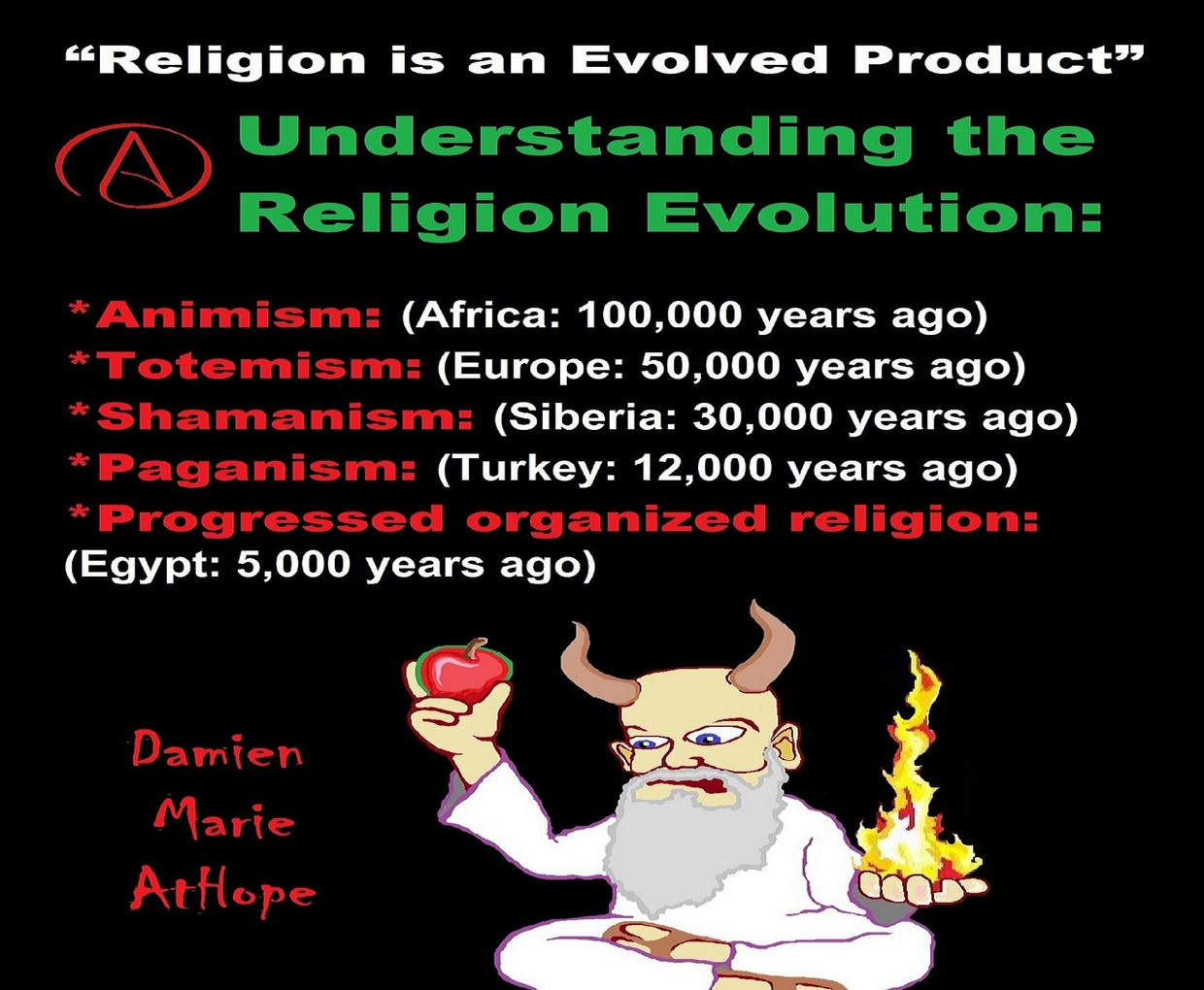

Not all “Religions” or “Religious Persuasions” have a god(s) but
All can be said to believe in some imaginary beings or imaginary things like spirits, afterlives, etc.

Paganism 12,000-4,000 years old
12,000-7,000 years old: related to (Pre-Capitalism)
7,000-5,000 years old: related to (Capitalism) (World War 0) Elite and their slaves!
5,000 years old: related to (Kings and the Rise of the State)
4,000 years old: related to (First Moralistic gods, then the Origin time of Monotheism)

ref, ref, ref, ref, ref, ref, ref, ref, ref, ref, ref, ref, ref, ref, ref, ref, ref, ref, ref, ref, ref
Low Gods “Earth” or Tutelary deity and High Gods “Sky” or Supreme deity
“An Earth goddess is a deification of the Earth. Earth goddesses are often associated with the “chthonic” deities of the underworld. Ki and Ninhursag are Mesopotamian earth goddesses. In Greek mythology, the Earth is personified as Gaia, corresponding to Roman Terra, Indic Prithvi/Bhūmi, etc. traced to an “Earth Mother” complementary to the “Sky Father” in Proto-Indo-European religion. Egyptian mythology exceptionally has a sky goddess and an Earth god.” ref
“A mother goddess is a goddess who represents or is a personification of nature, motherhood, fertility, creation, destruction or who embodies the bounty of the Earth. When equated with the Earth or the natural world, such goddesses are sometimes referred to as Mother Earth or as the Earth Mother. In some religious traditions or movements, Heavenly Mother (also referred to as Mother in Heaven or Sky Mother) is the wife or feminine counterpart of the Sky father or God the Father.” ref
“Any masculine sky god is often also king of the gods, taking the position of patriarch within a pantheon. Such king gods are collectively categorized as “sky father” deities, with a polarity between sky and earth often being expressed by pairing a “sky father” god with an “earth mother” goddess (pairings of a sky mother with an earth father are less frequent). A main sky goddess is often the queen of the gods and may be an air/sky goddess in her own right, though she usually has other functions as well with “sky” not being her main. In antiquity, several sky goddesses in ancient Egypt, Mesopotamia, and the Near East were called Queen of Heaven. Neopagans often apply it with impunity to sky goddesses from other regions who were never associated with the term historically. The sky often has important religious significance. Many religions, both polytheistic and monotheistic, have deities associated with the sky.” ref
“In comparative mythology, sky father is a term for a recurring concept in polytheistic religions of a sky god who is addressed as a “father”, often the father of a pantheon and is often either a reigning or former King of the Gods. The concept of “sky father” may also be taken to include Sun gods with similar characteristics, such as Ra. The concept is complementary to an “earth mother“. “Sky Father” is a direct translation of the Vedic Dyaus Pita, etymologically descended from the same Proto-Indo-European deity name as the Greek Zeûs Pater and Roman Jupiter and Germanic Týr, Tir or Tiwaz, all of which are reflexes of the same Proto-Indo-European deity’s name, *Dyēus Ph₂tḗr. While there are numerous parallels adduced from outside of Indo-European mythology, there are exceptions (e.g. In Egyptian mythology, Nut is the sky mother and Geb is the earth father).” ref
Tutelary deity
“A tutelary (also tutelar) is a deity or spirit who is a guardian, patron, or protector of a particular place, geographic feature, person, lineage, nation, culture, or occupation. The etymology of “tutelary” expresses the concept of safety and thus of guardianship. In late Greek and Roman religion, one type of tutelary deity, the genius, functions as the personal deity or daimon of an individual from birth to death. Another form of personal tutelary spirit is the familiar spirit of European folklore.” ref
“A tutelary (also tutelar) in Korean shamanism, jangseung and sotdae were placed at the edge of villages to frighten off demons. They were also worshiped as deities. Seonangshin is the patron deity of the village in Korean tradition and was believed to embody the Seonangdang. In Philippine animism, Diwata or Lambana are deities or spirits that inhabit sacred places like mountains and mounds and serve as guardians. Such as: Maria Makiling is the deity who guards Mt. Makiling and Maria Cacao and Maria Sinukuan. In Shinto, the spirits, or kami, which give life to human bodies come from nature and return to it after death. Ancestors are therefore themselves tutelaries to be worshiped. And similarly, Native American beliefs such as Tonás, tutelary animal spirit among the Zapotec and Totems, familial or clan spirits among the Ojibwe, can be animals.” ref
“A tutelary (also tutelar) in Austronesian beliefs such as: Atua (gods and spirits of the Polynesian peoples such as the Māori or the Hawaiians), Hanitu (Bunun of Taiwan‘s term for spirit), Hyang (Kawi, Sundanese, Javanese, and Balinese Supreme Being, in ancient Java and Bali mythology and this spiritual entity, can be either divine or ancestral), Kaitiaki (New Zealand Māori term used for the concept of guardianship, for the sky, the sea, and the land), Kawas (mythology) (divided into 6 groups: gods, ancestors, souls of the living, spirits of living things, spirits of lifeless objects, and ghosts), Tiki (Māori mythology, Tiki is the first man created by either Tūmatauenga or Tāne and represents deified ancestors found in most Polynesian cultures). ” ref, ref, ref, ref, ref, ref, ref
Mesopotamian Tutelary Deities can be seen as ones related to City-States
“Historical city-states included Sumerian cities such as Uruk and Ur; Ancient Egyptian city-states, such as Thebes and Memphis; the Phoenician cities (such as Tyre and Sidon); the five Philistine city-states; the Berber city-states of the Garamantes; the city-states of ancient Greece (the poleis such as Athens, Sparta, Thebes, and Corinth); the Roman Republic (which grew from a city-state into a vast empire); the Italian city-states from the Middle Ages to the early modern period, such as Florence, Siena, Ferrara, Milan (which as they grew in power began to dominate neighboring cities) and Genoa and Venice, which became powerful thalassocracies; the Mayan and other cultures of pre-Columbian Mesoamerica (including cities such as Chichen Itza, Tikal, Copán and Monte Albán); the central Asian cities along the Silk Road; the city-states of the Swahili coast; Ragusa; states of the medieval Russian lands such as Novgorod and Pskov; and many others.” ref
“The Uruk period (ca. 4000 to 3100 BCE; also known as Protoliterate period) of Mesopotamia, named after the Sumerian city of Uruk, this period saw the emergence of urban life in Mesopotamia and the Sumerian civilization. City-States like Uruk and others had a patron tutelary City Deity along with a Priest-King.” ref
“Chinese folk religion, both past, and present, includes myriad tutelary deities. Exceptional individuals, highly cultivated sages, and prominent ancestors can be deified and honored after death. Lord Guan is the patron of military personnel and police, while Mazu is the patron of fishermen and sailors. Such as Tu Di Gong (Earth Deity) is the tutelary deity of a locality, and each individual locality has its own Earth Deity and Cheng Huang Gong (City God) is the guardian deity of an individual city, worshipped by local officials and locals since imperial times.” ref
“A tutelary (also tutelar) in Hinduism, personal tutelary deities are known as ishta-devata, while family tutelary deities are known as Kuladevata. Gramadevata are guardian deities of villages. Devas can also be seen as tutelary. Shiva is the patron of yogis and renunciants. City goddesses include: Mumbadevi (Mumbai), Sachchika (Osian); Kuladevis include: Ambika (Porwad), and Mahalakshmi. In NorthEast India Meitei mythology and religion (Sanamahism) of Manipur, there are various types of tutelary deities, among which Lam Lais are the most predominant ones. Tibetan Buddhism has Yidam as a tutelary deity. Dakini is the patron of those who seek knowledge.” ref
“A tutelary (also tutelar) The Greeks also thought deities guarded specific places: for instance, Athena was the patron goddess of the city of Athens. Socrates spoke of hearing the voice of his personal spirit or daimonion:
You have often heard me speak of an oracle or sign which comes to me … . This sign I have had ever since I was a child. The sign is a voice which comes to me and always forbids me to do something which I am going to do, but never commands me to do anything, and this is what stands in the way of my being a politician.” ref
“Tutelary deities who guard and preserve a place or a person are fundamental to ancient Roman religion. The tutelary deity of a man was his Genius, that of a woman her Juno. In the Imperial era, the Genius of the Emperor was a focus of Imperial cult. An emperor might also adopt a major deity as his personal patron or tutelary, as Augustus did Apollo. Precedents for claiming the personal protection of a deity were established in the Republican era, when for instance the Roman dictator Sulla advertised the goddess Victory as his tutelary by holding public games (ludi) in her honor.” ref
“Each town or city had one or more tutelary deities, whose protection was considered particularly vital in time of war and siege. Rome itself was protected by a goddess whose name was to be kept ritually secret on pain of death (for a supposed case, see Quintus Valerius Soranus). The Capitoline Triad of Juno, Jupiter, and Minerva were also tutelaries of Rome. The Italic towns had their own tutelary deities. Juno often had this function, as at the Latin town of Lanuvium and the Etruscan city of Veii, and was often housed in an especially grand temple on the arx (citadel) or other prominent or central location. The tutelary deity of Praeneste was Fortuna, whose oracle was renowned.” ref
“The Roman ritual of evocatio was premised on the belief that a town could be made vulnerable to military defeat if the power of its tutelary deity were diverted outside the city, perhaps by the offer of superior cult at Rome. The depiction of some goddesses such as the Magna Mater (Great Mother, or Cybele) as “tower-crowned” represents their capacity to preserve the city. A town in the provinces might adopt a deity from within the Roman religious sphere to serve as its guardian, or syncretize its own tutelary with such; for instance, a community within the civitas of the Remi in Gaul adopted Apollo as its tutelary, and at the capital of the Remi (present-day Rheims), the tutelary was Mars Camulus.” ref
Household deity (a kind of or related to a Tutelary deity)
“A household deity is a deity or spirit that protects the home, looking after the entire household or certain key members. It has been a common belief in paganism as well as in folklore across many parts of the world. Household deities fit into two types; firstly, a specific deity – typically a goddess – often referred to as a hearth goddess or domestic goddess who is associated with the home and hearth, such as the ancient Greek Hestia.” ref
“The second type of household deities are those that are not one singular deity, but a type, or species of animistic deity, who usually have lesser powers than major deities. This type was common in the religions of antiquity, such as the Lares of ancient Roman religion, the Gashin of Korean shamanism, and Cofgodas of Anglo-Saxon paganism. These survived Christianisation as fairy-like creatures existing in folklore, such as the Anglo-Scottish Brownie and Slavic Domovoy.” ref
“Household deities were usually worshipped not in temples but in the home, where they would be represented by small idols (such as the teraphim of the Bible, often translated as “household gods” in Genesis 31:19 for example), amulets, paintings, or reliefs. They could also be found on domestic objects, such as cosmetic articles in the case of Tawaret. The more prosperous houses might have a small shrine to the household god(s); the lararium served this purpose in the case of the Romans. The gods would be treated as members of the family and invited to join in meals, or be given offerings of food and drink.” ref
“In many religions, both ancient and modern, a god would preside over the home. Certain species, or types, of household deities, existed. An example of this was the Roman Lares. Many European cultures retained house spirits into the modern period. Some examples of these include:
- Brownie (Scotland and England) or Hob (England) / Kobold (Germany) / Goblin / Hobgoblin
- Domovoy (Slavic)
- Nisse (Norwegian or Danish) / Tomte (Swedish) / Tonttu (Finnish)
- Húsvættir (Norse)” ref
“Although the cosmic status of household deities was not as lofty as that of the Twelve Olympians or the Aesir, they were also jealous of their dignity and also had to be appeased with shrines and offerings, however humble. Because of their immediacy they had arguably more influence on the day-to-day affairs of men than the remote gods did. Vestiges of their worship persisted long after Christianity and other major religions extirpated nearly every trace of the major pagan pantheons. Elements of the practice can be seen even today, with Christian accretions, where statues to various saints (such as St. Francis) protect gardens and grottos. Even the gargoyles found on older churches, could be viewed as guardians partitioning a sacred space.” ref
“For centuries, Christianity fought a mop-up war against these lingering minor pagan deities, but they proved tenacious. For example, Martin Luther‘s Tischreden have numerous – quite serious – references to dealing with kobolds. Eventually, rationalism and the Industrial Revolution threatened to erase most of these minor deities, until the advent of romantic nationalism rehabilitated them and embellished them into objects of literary curiosity in the 19th century. Since the 20th century this literature has been mined for characters for role-playing games, video games, and other fantasy personae, not infrequently invested with invented traits and hierarchies somewhat different from their mythological and folkloric roots.” ref
“In contradistinction to both Herbert Spencer and Edward Burnett Tylor, who defended theories of animistic origins of ancestor worship, Émile Durkheim saw its origin in totemism. In reality, this distinction is somewhat academic, since totemism may be regarded as a particularized manifestation of animism, and something of a synthesis of the two positions was attempted by Sigmund Freud. In Freud’s Totem and Taboo, both totem and taboo are outward expressions or manifestations of the same psychological tendency, a concept which is complementary to, or which rather reconciles, the apparent conflict. Freud preferred to emphasize the psychoanalytic implications of the reification of metaphysical forces, but with particular emphasis on its familial nature. This emphasis underscores, rather than weakens, the ancestral component.” ref
“William Edward Hearn, a noted classicist, and jurist, traced the origin of domestic deities from the earliest stages as an expression of animism, a belief system thought to have existed also in the neolithic, and the forerunner of Indo-European religion. In his analysis of the Indo-European household, in Chapter II “The House Spirit”, Section 1, he states:
The belief which guided the conduct of our forefathers was … the spirit rule of dead ancestors.” ref
“In Section 2 he proceeds to elaborate:
It is thus certain that the worship of deceased ancestors is a vera causa, and not a mere hypothesis. …
In the other European nations, the Slavs, the Teutons, and the Kelts, the House Spirit appears with no less distinctness. … [T]he existence of that worship does not admit of doubt. … The House Spirits had a multitude of other names which it is needless here to enumerate, but all of which are more or less expressive of their friendly relations with man. … In [England] … [h]e is the Brownie. … In Scotland this same Brownie is well known. He is usually described as attached to particular families, with whom he has been known to reside for centuries, threshing the corn, cleaning the house, and performing similar household tasks. His favorite gratification was milk and honey.” ref

ref, ref, ref, ref, ref, ref, ref, ref, ref, ref, ref, ref, ref, ref, ref, ref, ref
“These ideas are my speculations from the evidence.”
I am still researching the “god‘s origins” all over the world. So you know, it is very complicated but I am smart and willing to look, DEEP, if necessary, which going very deep does seem to be needed here, when trying to actually understand the evolution of gods and goddesses. I am sure of a few things and less sure of others, but even in stuff I am not fully grasping I still am slowly figuring it out, to explain it to others. But as I research more I am understanding things a little better, though I am still working on understanding it all or something close and thus always figuring out more.
Sky Father/Sky God?
“Egyptian: (Nut) Sky Mother and (Geb) Earth Father” (Egypt is different but similar)
Turkic/Mongolic: (Tengri/Tenger Etseg) Sky Father and (Eje/Gazar Eej) Earth Mother *Transeurasian*
Hawaiian: (Wākea) Sky Father and (Papahānaumoku) Earth Mother *Austronesian*
New Zealand/ Māori: (Ranginui) Sky Father and (Papatūānuku) Earth Mother *Austronesian*
Proto-Indo-European: (Dyḗus/Dyḗus ph₂tḗr) Sky Father and (Dʰéǵʰōm/Pleth₂wih₁) Earth Mother
Indo-Aryan: (Dyaus Pita) Sky Father and (Prithvi Mata) Earth Mother *Indo-European*
Italic: (Jupiter) Sky Father and (Juno) Sky Mother *Indo-European*
Etruscan: (Tinia) Sky Father and (Uni) Sky Mother *Tyrsenian/Italy Pre–Indo-European*
Hellenic/Greek: (Zeus) Sky Father and (Hera) Sky Mother who started as an “Earth Goddess” *Indo-European*
Nordic: (Dagr) Sky Father and (Nótt) Sky Mother *Indo-European*
Slavic: (Perun) Sky Father and (Mokosh) Earth Mother *Indo-European*
Illyrian: (Deipaturos) Sky Father and (Messapic Damatura’s “earth-mother” maybe) Earth Mother *Indo-European*
Albanian: (Zojz) Sky Father and (?) *Indo-European*
Baltic: (Perkūnas) Sky Father and (Saulė) Sky Mother *Indo-European*
Germanic: (Týr) Sky Father and (?) *Indo-European*
Colombian-Muisca: (Bochica) Sky Father and (Huythaca) Sky Mother *Chibchan*
Aztec: (Quetzalcoatl) Sky Father and (Xochiquetzal) Sky Mother *Uto-Aztecan*
Incan: (Viracocha) Sky Father and (Mama Runtucaya) Sky Mother *Quechuan*
China: (Tian/Shangdi) Sky Father and (Dì) Earth Mother *Sino-Tibetan*
Sumerian, Assyrian and Babylonian: (An/Anu) Sky Father and (Ki) Earth Mother
Finnish: (Ukko) Sky Father and (Akka) Earth Mother *Finno-Ugric*
Sami: (Horagalles) Sky Father and (Ravdna) Earth Mother *Finno-Ugric*
Puebloan-Zuni: (Ápoyan Ta’chu) Sky Father and (Áwitelin Tsíta) Earth Mother
Puebloan-Hopi: (Tawa) Sky Father and (Kokyangwuti/Spider Woman/Grandmother) Earth Mother *Uto-Aztecan*
Puebloan-Navajo: (Tsohanoai) Sky Father and (Estsanatlehi) Earth Mother *Na-Dene*
ref, ref, ref, ref, ref, ref, ref, ref, ref, ref, ref, ref, ref, ref, ref, ref, ref, ref, ref, ref, ref, ref, ref, ref, ref, ref, ref
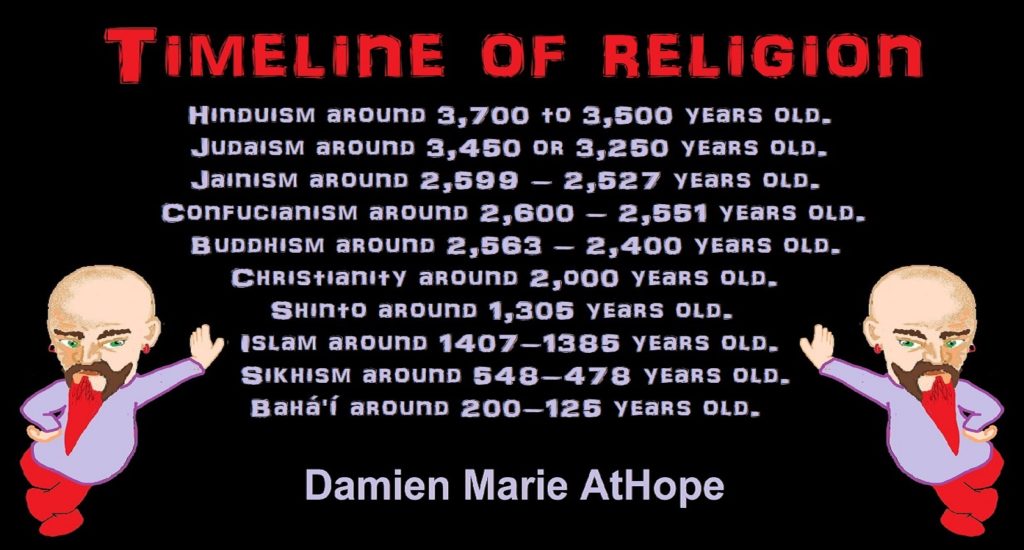
Hinduism around 3,700 to 3,500 years old. ref
Judaism around 3,450 or 3,250 years old. (The first writing in the bible was “Paleo-Hebrew” dated to around 3,000 years ago Khirbet Qeiyafa is the site of an ancient fortress city overlooking the Elah Valley. And many believe the religious Jewish texts were completed around 2,500) ref, ref
Judaism is around 3,450 or 3,250 years old. (“Paleo-Hebrew” 3,000 years ago and Torah 2,500 years ago)
“Judaism is an Abrahamic, its roots as an organized religion in the Middle East during the Bronze Age. Some scholars argue that modern Judaism evolved from Yahwism, the religion of ancient Israel and Judah, by the late 6th century BCE, and is thus considered to be one of the oldest monotheistic religions.” ref
“Yahwism is the name given by modern scholars to the religion of ancient Israel, essentially polytheistic, with a plethora of gods and goddesses. Heading the pantheon was Yahweh, the national god of the Israelite kingdoms of Israel and Judah, with his consort, the goddess Asherah; below them were second-tier gods and goddesses such as Baal, Shamash, Yarikh, Mot, and Astarte, all of whom had their own priests and prophets and numbered royalty among their devotees, and a third and fourth tier of minor divine beings, including the mal’ak, the messengers of the higher gods, who in later times became the angels of Judaism, Christianity and Islam. Yahweh, however, was not the ‘original’ god of Israel “Isra-El”; it is El, the head of the Canaanite pantheon, whose name forms the basis of the name “Israel”, and none of the Old Testament patriarchs, the tribes of Israel, the Judges, or the earliest monarchs, have a Yahwistic theophoric name (i.e., one incorporating the name of Yahweh).” ref
“El is a Northwest Semitic word meaning “god” or “deity“, or referring (as a proper name) to any one of multiple major ancient Near Eastern deities. A rarer form, ‘ila, represents the predicate form in Old Akkadian and in Amorite. The word is derived from the Proto-Semitic *ʔil-, meaning “god”. Specific deities known as ‘El or ‘Il include the supreme god of the ancient Canaanite religion and the supreme god of East Semitic speakers in Mesopotamia’s Early Dynastic Period. ʼĒl is listed at the head of many pantheons. In some Canaanite and Ugaritic sources, ʼĒl played a role as father of the gods, of creation, or both. For example, in the Ugaritic texts, ʾil mlk is understood to mean “ʼĒl the King” but ʾil hd as “the god Hadad“. The Semitic root ʾlh (Arabic ʾilāh, Aramaic ʾAlāh, ʾElāh, Hebrew ʾelōah) may be ʾl with a parasitic h, and ʾl may be an abbreviated form of ʾlh. In Ugaritic the plural form meaning “gods” is ʾilhm, equivalent to Hebrew ʾelōhîm “powers”. In the Hebrew texts this word is interpreted as being semantically singular for “god” by biblical commentators. However the documentary hypothesis for the Old Testament (corresponds to the Jewish Torah) developed originally in the 1870s, identifies these that different authors – the Jahwist, Elohist, Deuteronomist, and the Priestly source – were responsible for editing stories from a polytheistic religion into those of a monotheistic religion. Inconsistencies that arise between monotheism and polytheism in the texts are reflective of this hypothesis.” ref
Jainism around 2,599 – 2,527 years old. ref
Confucianism around 2,600 – 2,551 years old. ref
Buddhism around 2,563/2,480 – 2,483/2,400 years old. ref
Christianity around 2,o00 years old. ref
Shinto around 1,305 years old. ref
Islam around 1407–1385 years old. ref

Knowledge to Ponder:
Stars/Astrology:
- Possibly, around 30,000 years ago (in simpler form) to 6,000 years ago, Stars/Astrology are connected to Ancestors, Spirit Animals, and Deities.
- The star also seems to be a possible proto-star for Star of Ishtar, Star of Inanna, or Star of Venus.
- Around 7,000 to 6,000 years ago, Star Constellations/Astrology have connections to the “Kurgan phenomenon” of below-ground “mound” stone/wood burial structures and “Dolmen phenomenon” of above-ground stone burial structures.
- Around 6,500–5,800 years ago, The Northern Levant migrations into Jordon and Israel in the Southern Levant brought new cultural and religious transfer from Turkey and Iran.
- “The Ghassulian Star,” a mysterious 6,000-year-old mural from Jordan may have connections to the European paganstic kurgan/dolmens phenomenon.
“Astrology is a range of divinatory practices, recognized as pseudoscientific since the 18th century, that claim to discern information about human affairs and terrestrial events by studying the apparent positions of celestial objects. Different cultures have employed forms of astrology since at least the 2nd millennium BCE, these practices having originated in calendrical systems used to predict seasonal shifts and to interpret celestial cycles as signs of divine communications. Most, if not all, cultures have attached importance to what they observed in the sky, and some—such as the Hindus, Chinese, and the Maya—developed elaborate systems for predicting terrestrial events from celestial observations. Western astrology, one of the oldest astrological systems still in use, can trace its roots to 19th–17th century BCE Mesopotamia, from where it spread to Ancient Greece, Rome, the Islamicate world and eventually Central and Western Europe. Contemporary Western astrology is often associated with systems of horoscopes that purport to explain aspects of a person’s personality and predict significant events in their lives based on the positions of celestial objects; the majority of professional astrologers rely on such systems.” ref
Around 5,500 years ago, Science evolves, The first evidence of science was 5,500 years ago and was demonstrated by a body of empirical, theoretical, and practical knowledge about the natural world. ref
Around 5,000 years ago, Origin of Logics is a Naturalistic Observation (principles of valid reasoning, inference, & demonstration) ref
Around 4,150 to 4,000 years ago: The earliest surviving versions of the Sumerian Epic of Gilgamesh, which was originally titled “He who Saw the Deep” (Sha naqba īmuru) or “Surpassing All Other Kings” (Shūtur eli sharrī) were written. ref
Hinduism:
- 3,700 years ago or so, the oldest of the Hindu Vedas (scriptures), the Rig Veda was composed.
- 3,500 years ago or so, the Vedic Age began in India after the collapse of the Indus Valley Civilization.
Judaism:
- around 3,000 years ago, the first writing in the bible was “Paleo-Hebrew”
- around 2,500 years ago, many believe the religious Jewish texts were completed
Myths: The bible inspired religion is not just one religion or one myth but a grouping of several religions and myths
- Around 3,450 or 3,250 years ago, according to legend, is the traditionally accepted period in which the Israelite lawgiver, Moses, provided the Ten Commandments.
- Around 2,500 to 2,400 years ago, a collection of ancient religious writings by the Israelites based primarily upon the Hebrew Bible, Tanakh, or Old Testament is the first part of Christianity’s bible.
- Around 2,400 years ago, the most accepted hypothesis is that the canon was formed in stages, first the Pentateuch (Torah).
- Around 2,140 to 2,116 years ago, the Prophets was written during the Hasmonean dynasty, and finally the remaining books.
- Christians traditionally divide the Old Testament into four sections:
- The first five books or Pentateuch (Torah).
- The proposed history books telling the history of the Israelites from their conquest of Canaan to their defeat and exile in Babylon.
- The poetic and proposed “Wisdom books” dealing, in various forms, with questions of good and evil in the world.
- The books of the biblical prophets, warning of the consequences of turning away from God:
- Henotheism:
- Exodus 20:23 “You shall not make other gods besides Me (not saying there are no other gods just not to worship them); gods of silver or gods of gold, you shall not make for yourselves.”
- Polytheism:
- Judges 10:6 “Then the sons of Israel again did evil in the sight of the LORD, served the Baals and the Ashtaroth, the gods of Aram, the gods of Sidon, the gods of Moab, the gods of the sons of Ammon, and the gods of the Philistines; thus they forsook the LORD and did not serve Him.”
- 1 Corinthians 8:5 “For even if there are so-called gods whether in heaven or on earth, as indeed there are many gods and many lords.”
- Monotheism:
- Isaiah 43:10 “You are my witnesses,” declares the LORD, “and my servant whom I have chosen, so that you may know and believe me and understand that I am he. Before me no god was formed, nor will there be one after me.
Around 2,570 to 2,270 Years Ago, there is a confirmation of atheistic doubting as well as atheistic thinking, mainly by Greek philosophers. However, doubting gods is likely as old as the invention of gods and should destroy the thinking that belief in god(s) is the “default belief”. The Greek word is apistos (a “not” and pistos “faithful,”), thus not faithful or faithless because one is unpersuaded and unconvinced by a god(s) claim. Short Definition: unbelieving, unbeliever, or unbelief.

Expressions of Atheistic Thinking:
- Around 2,600 years ago, Ajita Kesakambali, ancient Indian philosopher, who is the first known proponent of Indian materialism. ref
- Around 2,535 to 2,475 years ago, Heraclitus, Greek pre-Socratic philosopher, a native of the Greek city Ephesus, Ionia, on the coast of Anatolia, also known as Asia Minor or modern Turkey. ref
- Around 2,500 to 2,400 years ago, according to The Story of Civilization book series certain African pygmy tribes have no identifiable gods, spirits, or religious beliefs or rituals, and even what burials accrue are without ceremony. ref
- Around 2,490 to 2,430 years ago, Empedocles, Greek pre-Socratic philosopher and a citizen of Agrigentum, a Greek city in Sicily. ref
- Around 2,460 to 2,370 years ago, Democritus, Greek pre-Socratic philosopher considered to be the “father of modern science” possibly had some disbelief amounting to atheism. ref
- Around 2,399 years ago or so, Socrates, a famous Greek philosopher was tried for sinfulness by teaching doubt of state gods. ref
- Around 2,341 to 2,270 years ago, Epicurus, a Greek philosopher known for composing atheistic critics and famously stated, “Is God willing to prevent evil, but not able? Then he is not omnipotent. Is he able, but not willing? Then he is malevolent. Is he both able and willing? Then whence cometh evil? Is he neither able nor willing? Then why call him god?” ref
This last expression by Epicurus, seems to be an expression of Axiological Atheism. To understand and utilize value or actually possess “Value Conscious/Consciousness” to both give a strong moral “axiological” argument (the problem of evil) as well as use it to fortify humanism and positive ethical persuasion of human helping and care responsibilities. Because value-blindness gives rise to sociopathic/psychopathic evil.

“Theists, there has to be a god, as something can not come from nothing.”
Well, thus something (unknown) happened and then there was something. This does not tell us what the something that may have been involved with something coming from nothing. A supposed first cause, thus something (unknown) happened and then there was something is not an open invitation to claim it as known, neither is it justified to call or label such an unknown as anything, especially an unsubstantiated magical thinking belief born of mythology and religious storytelling.


While hallucinogens are associated with shamanism, it is alcohol that is associated with paganism.
The Atheist-Humanist-Leftist Revolutionaries Shows in the prehistory series:
Show two: Pre-animism 300,000 years old and animism 100,000 years old: related to “Anarchism and Socialism”
Show tree: Totemism 50,000 years old: related to “Anarchism and Socialism”
Show four: Shamanism 30,000 years old: related to “Anarchism and Socialism”
Show five: Paganism 12,000 years old: related to “Anarchism and Socialism”
Show six: Emergence of hierarchy, sexism, slavery, and the new male god dominance: Paganism 7,000-5,000 years old: related to “Anarchism and Socialism” (Capitalism) (World War 0) Elite and their slaves!
Prehistory: related to “Anarchism and Socialism” the division of labor, power, rights, and recourses: VIDEO
Pre-animism 300,000 years old and animism 100,000 years old: related to “Anarchism and Socialism”: VIDEO
Totemism 50,000 years old: related to “Anarchism and Socialism”: VIDEO
Shamanism 30,000 years old: related to “Anarchism and Socialism”: VIDEO
Paganism 12,000 years old: related to “Anarchism and Socialism” (Pre-Capitalism): VIDEO
Paganism 7,000-5,000 years old: related to “Anarchism and Socialism” (Capitalism) (World War 0) Elite and their slaves: VIEDO
Paganism 5,000 years old: progressed organized religion and the state: related to “Anarchism and Socialism” (Kings and the Rise of the State): VIEDO
Paganism 4,000 years old: related to “Anarchism and Socialism” (First Moralistic gods, then the Origin time of Monotheism): VIEDO
I do not hate simply because I challenge and expose myths or lies any more than others being thought of as loving simply because of the protection and hiding from challenge their favored myths or lies.
The truth is best championed in the sunlight of challenge.
An archaeologist once said to me “Damien religion and culture are very different”
My response, So are you saying that was always that way, such as would you say Native Americans’ cultures are separate from their religions? And do you think it always was the way you believe?
I had said that religion was a cultural product. That is still how I see it and there are other archaeologists that think close to me as well. Gods too are the myths of cultures that did not understand science or the world around them, seeing magic/supernatural everywhere.
I personally think there is a goddess and not enough evidence to support a male god at Çatalhöyük but if there was both a male and female god and goddess then I know the kind of gods they were like Proto-Indo-European mythology.
This series idea was addressed in, Anarchist Teaching as Free Public Education or Free Education in the Public: VIDEO
Our 12 video series: Organized Oppression: Mesopotamian State Force and the Politics of power (9,000-4,000 years ago), is adapted from: The Complete and Concise History of the Sumerians and Early Bronze Age Mesopotamia (7000-2000 BC): https://www.youtube.com/watch?v=szFjxmY7jQA by “History with Cy“
Show #1: Mesopotamian State Force and the Politics of Power (Samarra, Halaf, Ubaid)
Show #2: Mesopotamian State Force and the Politics of Power
Show #3: Mesopotamian State Force and the Politics of Power (Uruk and the First Cities)
Show #4: Mesopotamian State Force and the Politics of Power (First Kings)
Show #5: Mesopotamian State Force and the Politics of Power (Early Dynastic Period)
Show #6: Mesopotamian State Force and the Politics of Power
Show #7: Mesopotamian State Force and the Politics of Power (Sargon and Akkadian Rule)
Show #9: Mesopotamian State Force and the Politics of Power (Gudea of Lagash and Utu-hegal)
Show #12: Mesopotamian State Force and the Politics of Power (Aftermath and Legacy of Sumer)

The “Atheist-Humanist-Leftist Revolutionaries”
Cory Johnston ☭ Ⓐ Atheist Leftist @Skepticallefty & I (Damien Marie AtHope) @AthopeMarie (my YouTube & related blog) are working jointly in atheist, antitheist, antireligionist, antifascist, anarchist, socialist, and humanist endeavors in our videos together, generally, every other Saturday.
Why Does Power Bring Responsibility?
Think, how often is it the powerless that start wars, oppress others, or commit genocide? So, I guess the question is to us all, to ask, how can power not carry responsibility in a humanity concept? I know I see the deep ethical responsibility that if there is power their must be a humanistic responsibility of ethical and empathic stewardship of that power. Will I be brave enough to be kind? Will I possess enough courage to be compassionate? Will my valor reach its height of empathy? I as everyone, earns our justified respect by our actions, that are good, ethical, just, protecting, and kind. Do I have enough self-respect to put my love for humanity’s flushing, over being brought down by some of its bad actors? May we all be the ones doing good actions in the world, to help human flourishing.
I create the world I want to live in, striving for flourishing. Which is not a place but a positive potential involvement and promotion; a life of humanist goal precision. To master oneself, also means mastering positive prosocial behaviors needed for human flourishing. I may have lost a god myth as an atheist, but I am happy to tell you, my friend, it is exactly because of that, leaving the mental terrorizer, god belief, that I truly regained my connected ethical as well as kind humanity.
Cory and I will talk about prehistory and theism, addressing the relevance to atheism, anarchism, and socialism.
At the same time as the rise of the male god, 7,000 years ago, there was also the very time there was the rise of violence, war, and clans to kingdoms, then empires, then states. It is all connected back to 7,000 years ago, and it moved across the world.
Cory Johnston: https://damienmarieathope.com/2021/04/cory-johnston-mind-of-a-skeptical-leftist/?v=32aec8db952d
The Mind of a Skeptical Leftist (YouTube)
Cory Johnston: Mind of a Skeptical Leftist @Skepticallefty
The Mind of a Skeptical Leftist By Cory Johnston: “Promoting critical thinking, social justice, and left-wing politics by covering current events and talking to a variety of people. Cory Johnston has been thoughtfully talking to people and attempting to promote critical thinking, social justice, and left-wing politics.” http://anchor.fm/skepticalleft
Cory needs our support. We rise by helping each other.
Cory Johnston ☭ Ⓐ @Skepticallefty Evidence-based atheist leftist (he/him) Producer, host, and co-host of 4 podcasts @skeptarchy @skpoliticspod and @AthopeMarie
Damien Marie AtHope (“At Hope”) Axiological Atheist, Anti-theist, Anti-religionist, Secular Humanist. Rationalist, Writer, Artist, Poet, Philosopher, Advocate, Activist, Psychology, and Armchair Archaeology/Anthropology/Historian.
Damien is interested in: Freedom, Liberty, Justice, Equality, Ethics, Humanism, Science, Atheism, Antiteism, Antireligionism, Ignosticism, Left-Libertarianism, Anarchism, Socialism, Mutualism, Axiology, Metaphysics, LGBTQI, Philosophy, Advocacy, Activism, Mental Health, Psychology, Archaeology, Social Work, Sexual Rights, Marriage Rights, Woman’s Rights, Gender Rights, Child Rights, Secular Rights, Race Equality, Ageism/Disability Equality, Etc. And a far-leftist, “Anarcho-Humanist.”
I am not a good fit in the atheist movement that is mostly pro-capitalist, I am anti-capitalist. Mostly pro-skeptic, I am a rationalist not valuing skepticism. Mostly pro-agnostic, I am anti-agnostic. Mostly limited to anti-Abrahamic religions, I am an anti-religionist.
To me, the “male god” seems to have either emerged or become prominent around 7,000 years ago, whereas the now favored monotheism “male god” is more like 4,000 years ago or so. To me, the “female goddess” seems to have either emerged or become prominent around 11,000-10,000 years ago or so, losing the majority of its once prominence around 2,000 years ago due largely to the now favored monotheism “male god” that grow in prominence after 4,000 years ago or so.
My Thought on the Evolution of Gods?
Animal protector deities from old totems/spirit animal beliefs come first to me, 13,000/12,000 years ago, then women as deities 11,000/10,000 years ago, then male gods around 7,000/8,000 years ago. Moralistic gods around 5,000/4,000 years ago, and monotheistic gods around 4,000/3,000 years ago.
To me, animal gods were likely first related to totemism animals around 13,000 to 12,000 years ago or older. Female as goddesses was next to me, 11,000 to 10,000 years ago or so with the emergence of agriculture. Then male gods come about 8,000 to 7,000 years ago with clan wars. Many monotheism-themed religions started in henotheism, emerging out of polytheism/paganism.


Damien Marie AtHope (Said as “At” “Hope”)/(Autodidact Polymath but not good at math):
Axiological Atheist, Anti-theist, Anti-religionist, Secular Humanist, Rationalist, Writer, Artist, Jeweler, Poet, “autodidact” Philosopher, schooled in Psychology, and “autodidact” Armchair Archaeology/Anthropology/Pre-Historian (Knowledgeable in the range of: 1 million to 5,000/4,000 years ago). I am an anarchist socialist politically. Reasons for or Types of Atheism
My Website, My Blog, & Short-writing or Quotes, My YouTube, Twitter: @AthopeMarie, and My Email: damien.marie.athope@gmail.com


